Table of Contents
- Introduction
- Editor’s Choice
- Global Asthma Prevalence Statistics
- Asthma Symptoms Statistics
- Asthma Allergies Statistics
- Prevalence of Asthma in North America
- Prevalence of Asthma in Europe
- Prevalence of Asthma in Asia-Pacific
- Prevalence of Asthma in Africa
- Age-related Dynamics of Asthma Patients
- Gender-related Dynamics of Asthma Patients
- Ethnicity-related Dynamics of Asthma Patients
- Asthma Treatment Statistics
- Spending and Investments in Asthma Treatment
- Attacks of Asthma Among Different Occupations
- Asthma Care Measures
- Initiatives to Combat Asthma
- Regulations for Asthma Treatment
- Recent Developments
- Conclusion
- FAQs
Introduction
Asthma Statistics: Asthma is a chronic inflammatory disorder of the airways affecting approximately 262 million people worldwide, with a particularly high prevalence among children.
It is characterized by symptoms such as wheezing, shortness of breath, chest tightness, and coughing. Which results from airway inflammation, bronchial hyper-responsiveness, and airflow limitation.
Diagnosis typically involves medical history, physical examination, and lung function tests like spirometry. Management focuses on controlling symptoms through pharmacological interventions.
Including bronchodilators and anti-inflammatory medications, alongside non-pharmacological strategies like trigger avoidance and patient education.
Effective management can lead to a normal quality of life. Uncontrolled asthma poses risks, including severe exacerbations and decreased lung function.
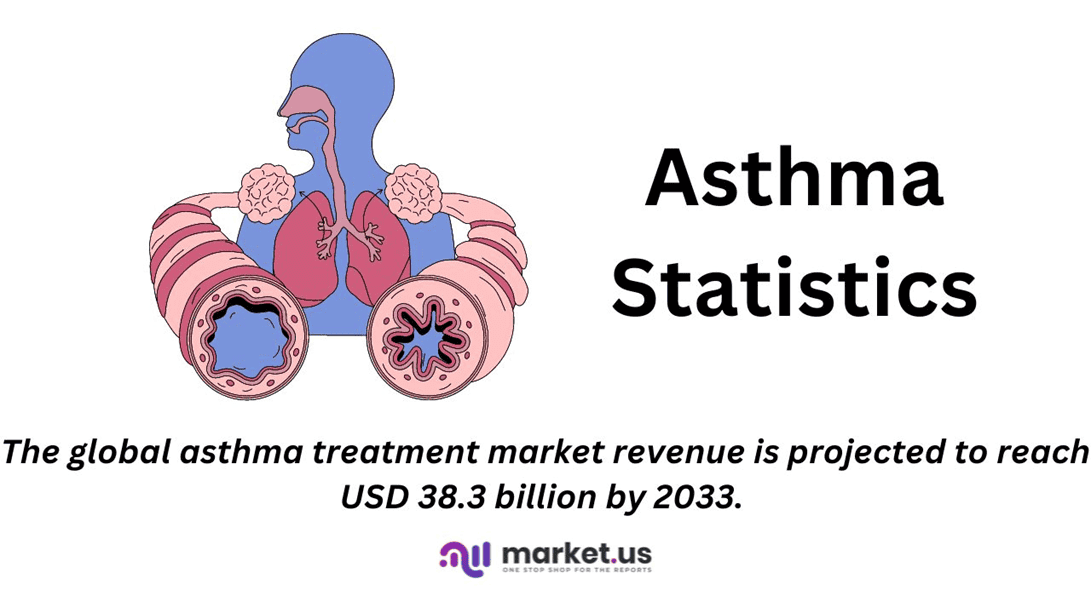
Editor’s Choice
- In a review of asthma death rates per 100,000 individuals across various countries, Kiribati reported the highest rate at 75.35.
- In 2019, the prevalence of asthma across the European Union varied significantly among member countries. Portugal reported the highest prevalence at 9.97%.
- The global asthma treatment market revenue is projected to reach USD 38.3 billion by 2033.
- The revenue for the global market for asthma and COPD drugs is expected to reach USD 64.6 billion by 2033.
- In 2018, the top 10 asthma medications by revenue showcased significant contributions from major pharmaceutical companies, tallying billions in U.S. dollars. Leading the pack was Seretide/Advair from GlaxoSmithKline, generating $3.22 billion.
- Between 2011 and 2016, the prevalence of asthma attacks among U.S. working adults with current asthma varied significantly across different occupational sectors. Education, training, and library professionals experienced the highest prevalence, with 51.50% reporting asthma attacks within the past 12 months.
- In the U.S., the National Asthma Control Program (NACP) works to reduce asthma-related morbidity and mortality by implementing evidence-based practices.
Global Asthma Prevalence Statistics
Global Prevalence of Clinical Asthma – By Country Statistics
- As of 2004, the prevalence of clinical asthma varied significantly across selected countries worldwide.
- Scotland had the highest percentage of its population affected, with 18.4% experiencing the condition.
- England followed closely with 15.3%, while Australia and Canada reported 14.7% and 14.1%, respectively.
- In Peru, 13.0% of the population was diagnosed with asthma, compared to 10.9% in the United States.
- South Africa recorded a prevalence of 8.1%, while Germany and Japan showed slightly lower rates at 6.9% and 6.7%, respectively.
- Saudi Arabia had a prevalence of 5.6%, and China reported the lowest rate among the selected countries. With 2.1% of its population affected by asthma.
(Source: Statista)
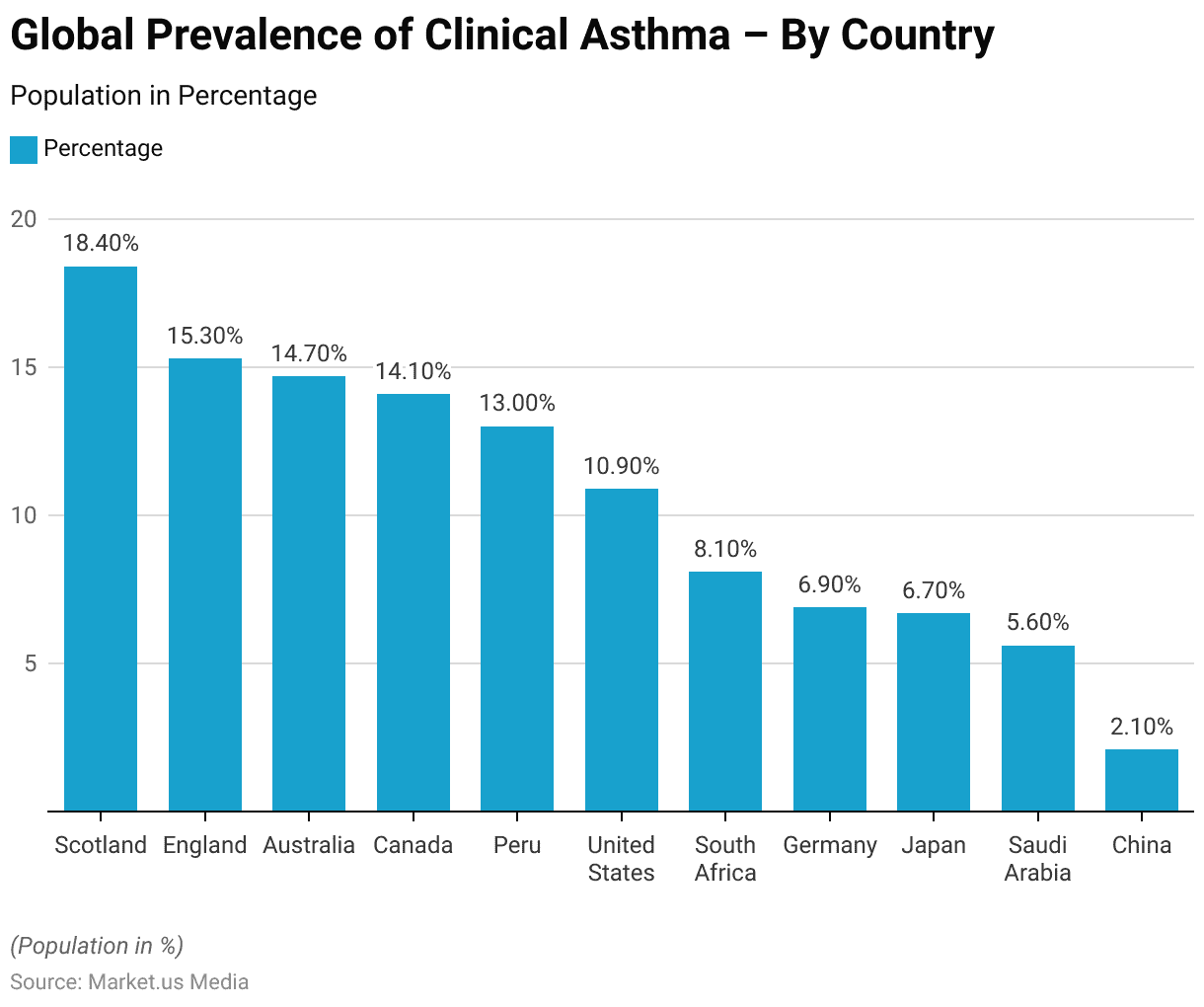
Fatality Asthma Rates – By Country Statistics
- As of 2004, asthma fatality rates per 100,000 asthmatics showed considerable variation across selected countries.
- China recorded the highest fatality rate, with 36.7 deaths per 100,000 asthmatics, followed by Russia at 28.6.
- South Africa had a significantly lower rate of 18.5, while Japan reported 8.7 deaths per 100,000 asthmatics.
- In the United States and Germany, the fatality rates were relatively low at 5.2 and 5.1, respectively.
- Australia, England, and Scotland reported similarly low figures, with 3.8, 3.2, and 3.0 deaths per 100,000 asthmatics, respectively.
- Brazil and Canada had the lowest rates, with 1.8 and 1.6 deaths per 100,000 asthmatics. Reflecting relatively favorable outcomes in these countries.
(Source: Statista)
Take advantage of our unbeatable offer - buy now!

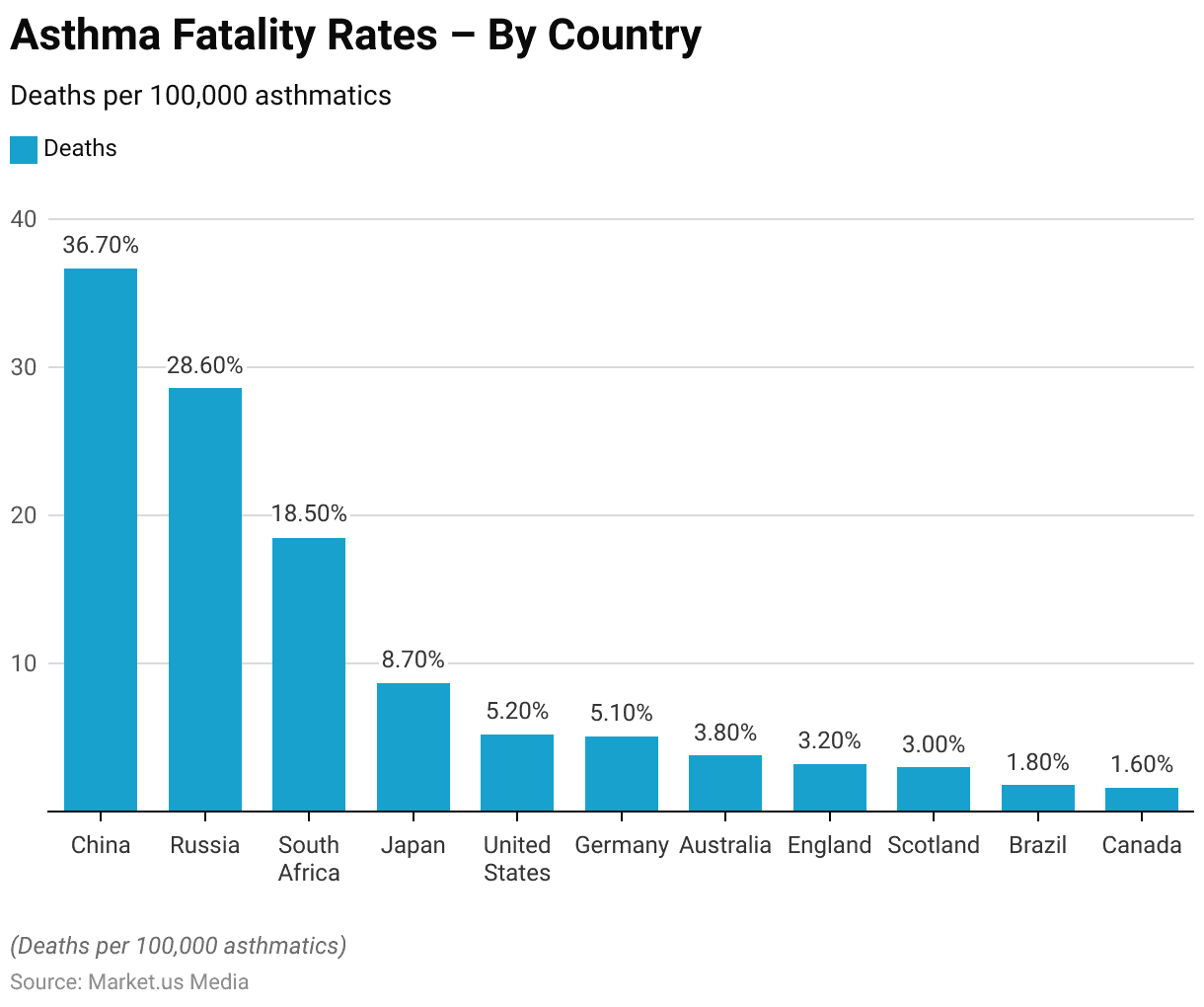
Asthma Death Rate – By Country Statistics
- In a review of asthma death rates per 100,000 individuals across various countries,
- Kiribati reported the highest rate at 75.35, followed by New Guinea at 47.57 and Lesotho at 45.32.
- Central African Republic and Fiji also had high rates, at 38.64 and 38.33, respectively.
- In Nepal, the death rate was 30.93, while Vanuatu reported 29.89. Micronesia and Somalia recorded rates of 26.17 and 25.62, respectively.
- Slightly lower, Sri Lanka and Myanmar had death rates of 25.43 and 24.48.
- The Solomon Islands and Afghanistan both had rates close to 24.35 and 24.23. With Zimbabwe and Swaziland just slightly less at 24.21 and 24.19.
- São Tomé and Guinea reported rates of 24.13 and 21.49, respectively.
- The Democratic Republic of the Congo showed a rate of 20.76. While Niger, Chad, and Mali recorded rates of 20.43, 20.15, and 19.95.
- Laos and Guinea-Bissau had rates of 19.6 and 19.1. While India and Madagascar reported lower rates of 18.49 and 17.92, respectively.
(Source: World Expectancy)
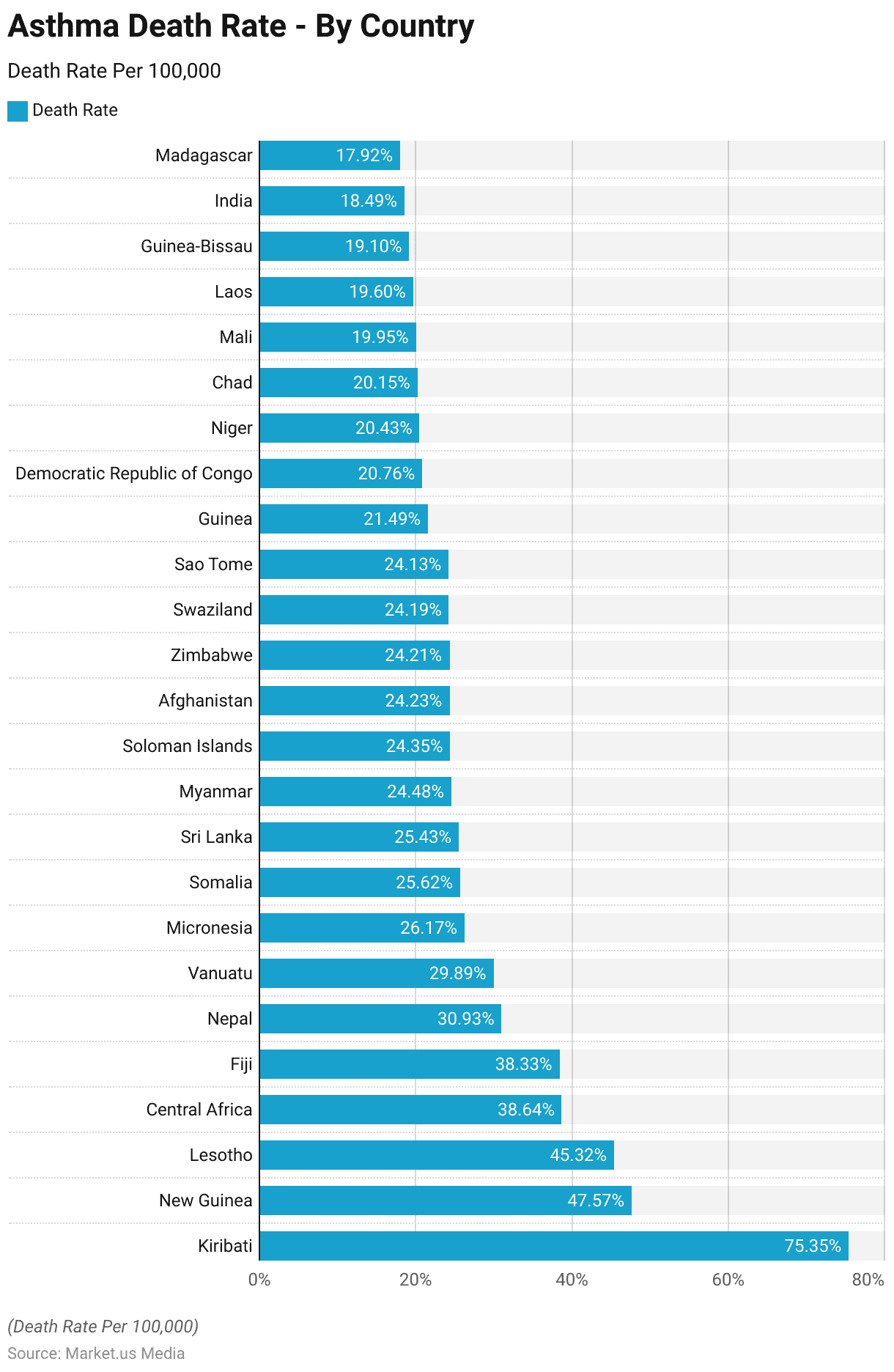
Asthma Symptoms Statistics
Global Distribution of Clinical Asthma Prevalence and Related Symptoms Statistics
- The prevalence and characteristics of clinical asthma across different regions worldwide show significant variation.
- In Africa, the prevalence of clinical asthma is 4.19%, with 12.65% of this population being current smokers and 78.85% having received asthma treatment, with 53.20% reporting wheezing.
- In the Americas, the asthma prevalence is slightly higher at 4.40%. With a greater percentage of smokers at 22.20% and 82.62% of asthma cases receiving treatment. However, a lower incidence of wheezing at 38.12% is observed.
- The Eastern Mediterranean region reports a clinical asthma prevalence of 2.99%. With 19.41% smokers, the highest treatment rate at 85.52%, and 54.45% experiencing wheezing.
- Europe sees the highest prevalence at 5.28%, with a notable 39.25% smoking rate. The highest treatment percentage at 90.24%, and 49.64% reported wheezing.
- South East Asia has a prevalence of 3.39%, with 30.23% smokers, 78.00% receiving treatment, and the highest wheezing percentage at 57.86%.
- The Western Pacific has the highest regional prevalence at 6.17%, with 31.46% smokers, 77.11% treated for asthma, and 50.84% experiencing wheezing.
- Globally, the average prevalence stands at 4.46%, with 23.46% being smokers, 81.91% being treated for asthma, and 49.69% reporting wheezing symptoms in the last year.
(Source: National Library of Medicine)
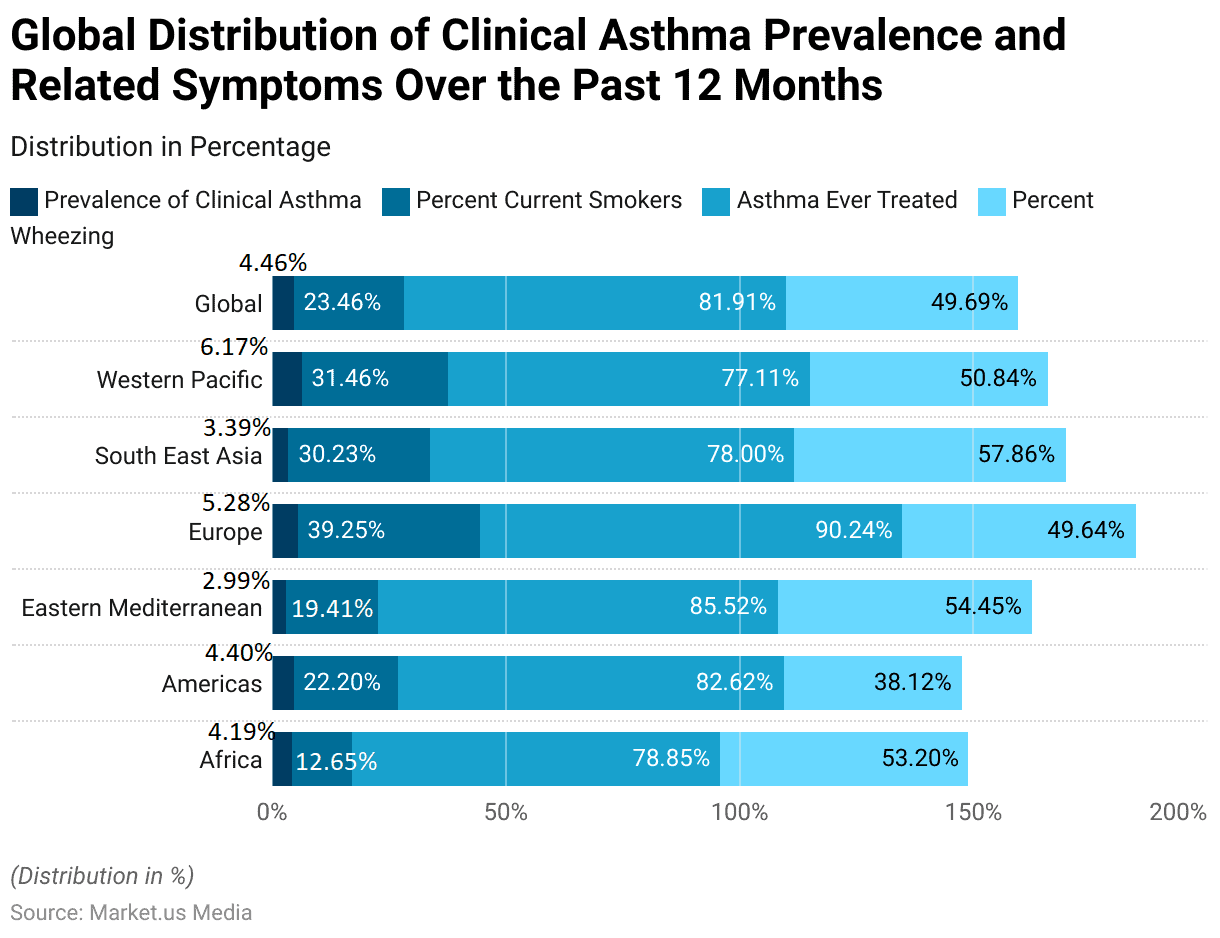
Prevalence of Asthma Symptoms Among Adolescents and Teenagers Statistics
- The International Study of Asthma and Allergies in Childhood (ISAAC), conducted between 2000 and 2003, surveyed 798,685 adolescents aged 13-14 from 233 centers across 97 countries.
- This study aimed to assess the prevalence of wheezing, a common symptom of asthma, over the past 12 months. Findings revealed significant variations in the prevalence of recent wheeze both between and within countries.
- The highest prevalence rates (≥20%) were predominantly seen in English-speaking countries of Australasia, Europe, North America, and parts of Latin America.
- In contrast, the lowest rates (<5%) were recorded in regions such as the Indian subcontinent, Asia-Pacific, Eastern Mediterranean, and Northern and Eastern Europe.
- Furthermore, the study highlighted considerable disparities in the prevalence of severe asthma symptoms in the preceding 12 months.
- These symptoms included four or more wheeze attacks. Frequent nocturnal awakening due to asthma, and episodes of wheeze intense enough to limit speech.
- Many centers reported severe symptoms affecting over 7.5% of the adolescent population, underscoring the substantial global variation in asthma severity.
(Source: Global Asthma Report – 2018)
Asthma Symptoms: Well Controlled Statistics
- In 2016, a survey in Europe assessed the control of asthma symptoms among patients. Revealing that a significant portion of respondents reported their asthma as completely or well-controlled within the past four weeks.
- The United Kingdom had the highest share of respondents indicating well-controlled asthma symptoms, at 88%.
- Germany followed, with 82% of respondents feeling their asthma was well managed.
- In Spain, 75% reported well-controlled symptoms, while Italy had the lowest among the surveyed countries. With 65% of respondents stating their asthma was completely or well-controlled.
- This data highlights the varying levels of asthma management success across different European countries.
(Source: Statista)
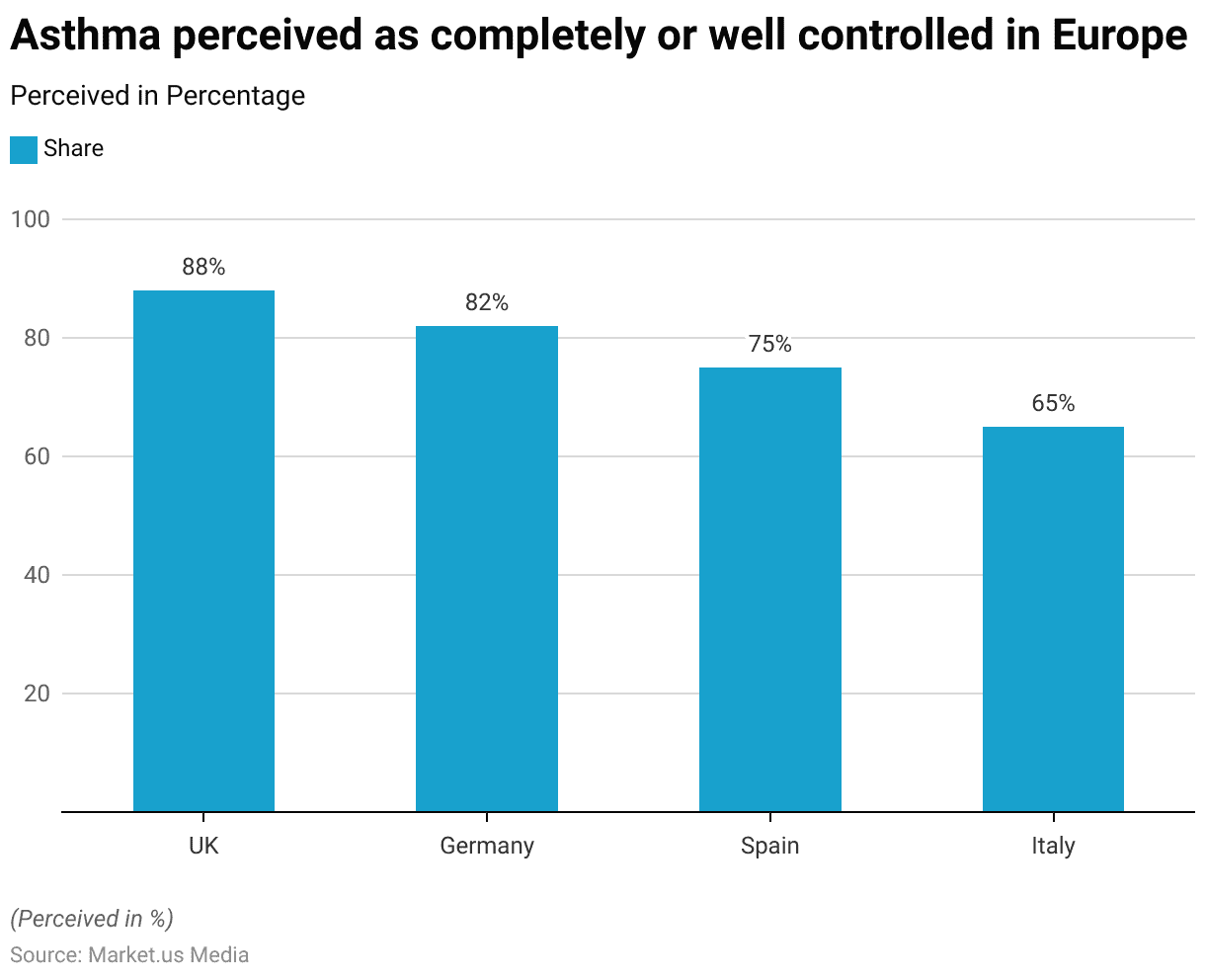
Asthma Allergies Statistics
- In 2020, the prevalence of people diagnosed with asthma and chronic allergies in various regions of Spain showed distinct patterns.
- Murcia reported the highest prevalence of chronic allergies at 16.59%, with asthma diagnoses at 4.91%.
- The Community of Madrid followed closely with 15.70% for allergies and 4.53% for asthma.
- Galicia also had a notable prevalence, with 14.72% suffering from chronic allergies and 6.09% from asthma.
- Castile Leon and Aragon had lower asthma rates at 3.10% and 2.63%, respectively. But higher allergy rates at 13.57% and 13.53%.
- Asturias and the Canary Islands presented higher asthma rates at 5.60% and 5.52%, respectively, alongside 12.45% and 9.75% for allergies.
- Other regions such as Catalonia, Andalusia, and the Basque Country showed moderate levels. Catalonia has 9.04% for allergies and 3.64% for asthma, Andalusia at 8.62% for allergies and 3.24% for asthma, and the Basque Country at 8.65% and 4.50%.
- The Balearic Islands and Cantabria had higher rates of asthma at 5.99% and 7.35%. With allergies at 6.90% and 6.85%, respectively.
- The autonomous cities of Ceuta and Melilla had some of the lowest rates. Melilla shows the lowest at 4.23% for allergies, 3.42% for asthma, and Ceuta at 6.78% and 5.73%.
- These figures illustrate significant regional variability in the prevalence of asthma and allergies within Spain.
(Source: Statista)
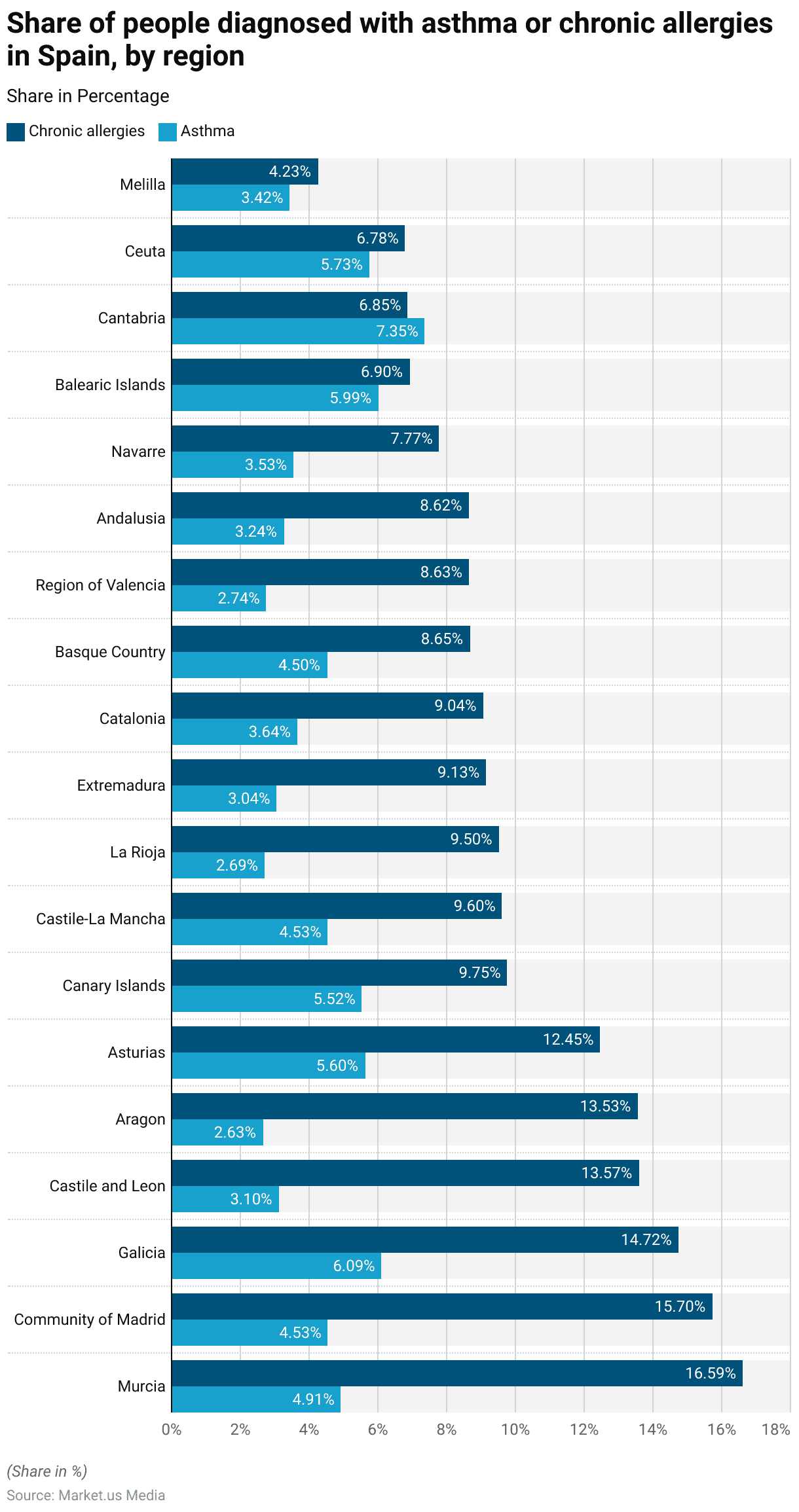
Prevalence of Asthma in North America
Prevalence of Current Asthma in the United States Statistics
- From 2001 to 2021, the percentage of the U.S. population diagnosed with current asthma exhibited fluctuations, according to a 20-year study.
- In 2001, the rate was 7.40%, slightly decreasing to 7.20% in 2002 and dropping to 7% in 2003.
- The percentage rose gradually over the next several years. Reaching 7.80% in 2006 and peaking at 8.50% in both 2010 and 2011.
- After a slight decrease to 8.30% in 2012, there was a more significant drop to 7.30% in 2013.
- The rates remained relatively stable, around 7.70% to 7.80% from 2014 through 2016, peaking again at 8.30% in 2016.
- Subsequent years saw a mild fluctuation, with the rate slightly declining to stabilize around 7.70% to 7.80% from 2017 through 2020 and ending at 7.70% in 2021.
- These variations reflect the ongoing public health challenges and responses related to asthma management in the United States over the last two decades.
(Source: Statista)
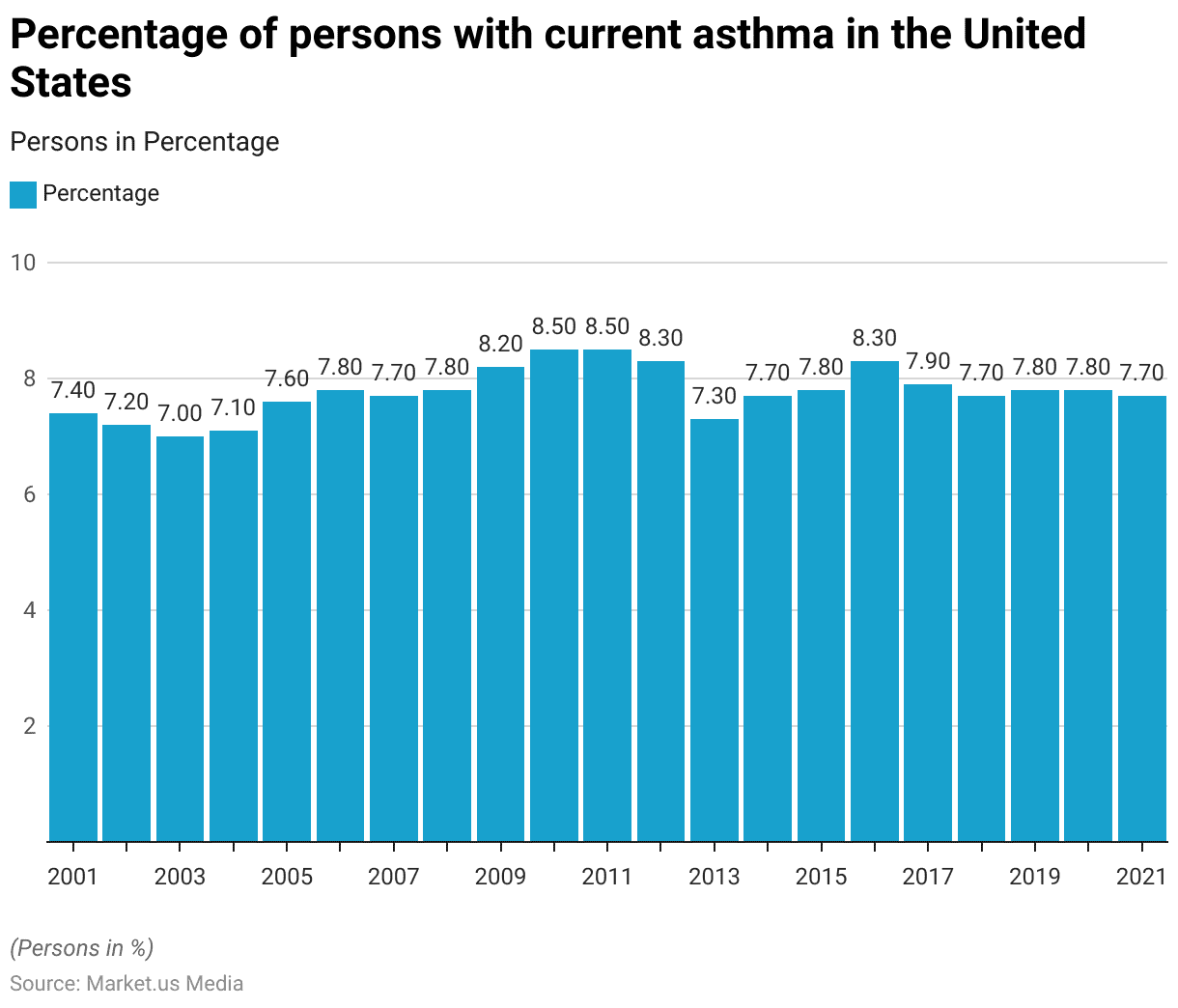
Asthma Prevalence in Canada Statistics
- In the 2021-2022 period, the prevalence of asthma among Canadians varied notably across provinces and territories.
- Manitoba reported the highest prevalence at 13.24%, closely followed by Ontario with a rate of 13.22%.
- The national average for Canada was 11.94%.
- Newfoundland and Labrador also showed a higher prevalence at 11.70%. While Quebec and Nova Scotia recorded rates of 11.47% and 11.46%, respectively.
- Alberta and Prince Edward Island had similar figures, with prevalences of 10.91% and 10.89% respectively.
- British Columbia had a lower rate at 10%.
- In contrast, the Yukon and Nunavut reported significantly lower asthma prevalence rates at 7.70% and 4.39%, respectively.
- These statistics illustrate the regional variations in asthma prevalence across Canada.
(Source: Statista)

Prevalence of Asthma in Europe
Prevalence of Asthma in the European Union Statistics
- In 2019, the prevalence of asthma across the European Union varied significantly among member countries.
- Portugal reported the highest prevalence at 9.97%, followed by Sweden with 8.24%.
- Other countries with notable rates included Malta at 7.78%,
- Cyprus at 7.69%, and the Netherlands at 7.66%.
- Ireland and Luxembourg also showed high prevalence rates of 7.56% and 7.46%, respectively. While France reported a prevalence of 7.22%.
- Finland’s rate stood at 6.70%, slightly above the E.U. average of 6.07%.
- Countries like Poland and Greece had rates of 5.88% and 5.79%, respectively. With Austria close behind at 5.72%.
- Denmark reported a prevalence of 5.29%, and Belgium 5.07%. Slovenia and Spain had similar rates of around 4.95%.
- Germany and Romania reported lower prevalence rates of 4.55% and 4.47%, respectively. Italy, Croatia, and Bulgaria had even lower rates, ranging from about 4.33% to 3.87%.
- Hungary, Latvia, Czechia, Slovakia, Lithuania, and Estonia reported the lowest asthma prevalence rates in the E.U. Ranging from 3.56% down to 2.24%, with Estonia having the lowest rate overall.
(Source: Statista)
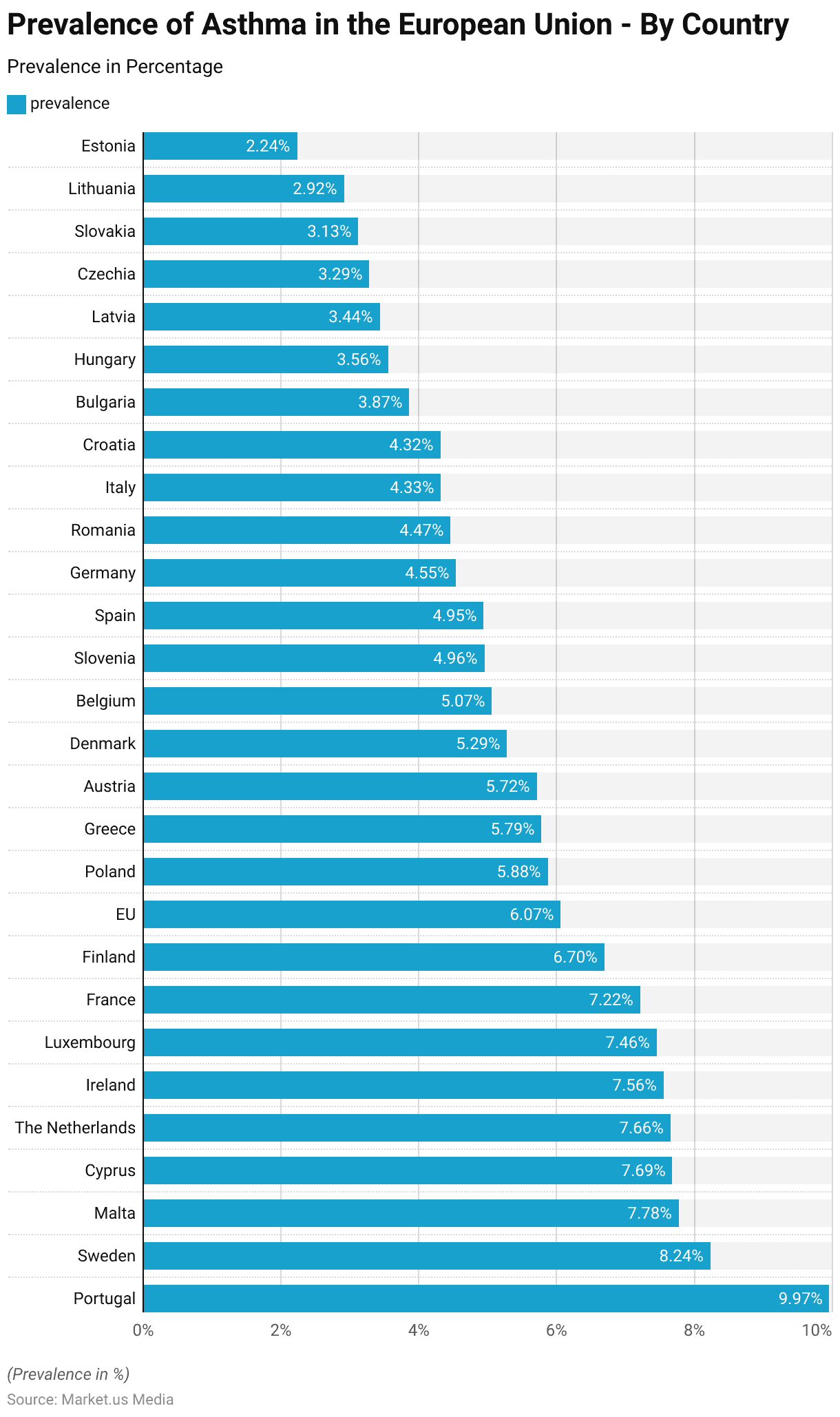
Population with Self-Reported Asthma in Europe Statistics
- In 2014, hospital admission rates for asthma per 100,000 population in Europe showcased notable disparities among different countries.
- The United Kingdom led with a rate of 9.4, closely followed by Finland at 9.2 and France at 8.8.
- Sweden also reported a significant number of admissions, standing at 7.6, while Luxembourg had 6.8.
- Denmark and the collective E.U. 26, which includes several European nations, both reported a rate of 6.5 and 6.1, respectively.
- Germany matched the E.U. 26 average with its rate of 6.1. Slightly lower rates were seen in Malta and the Netherlands, with 5.8 and 5.5, respectively.
- Portugal and Slovenia both had an admission rate of 5.0, while Hungary was slightly lower at 4.9.
- The Czech Republic and Spain reported rates of 4.5, closely mirroring the rates in Greece and Austria, each at 4.4.
- Belgium and Cyprus had a similar scenario, both recording a rate of 4.3.
- Poland’s rate was slightly lower at 4.1, followed by Slovakia at 3.9. Latvia reported a rate of 3.5, and Estonia was at 3.1.
- Croatia, Bulgaria, Lithuania, and Romania showed the lowest rates, with 3.0, 2.7, 2.7, and 2.0, respectively.
- These statistics reflect a broad range of asthma hospital admissions across Europe, with marked variations from one country to another.
(Source: Statista)
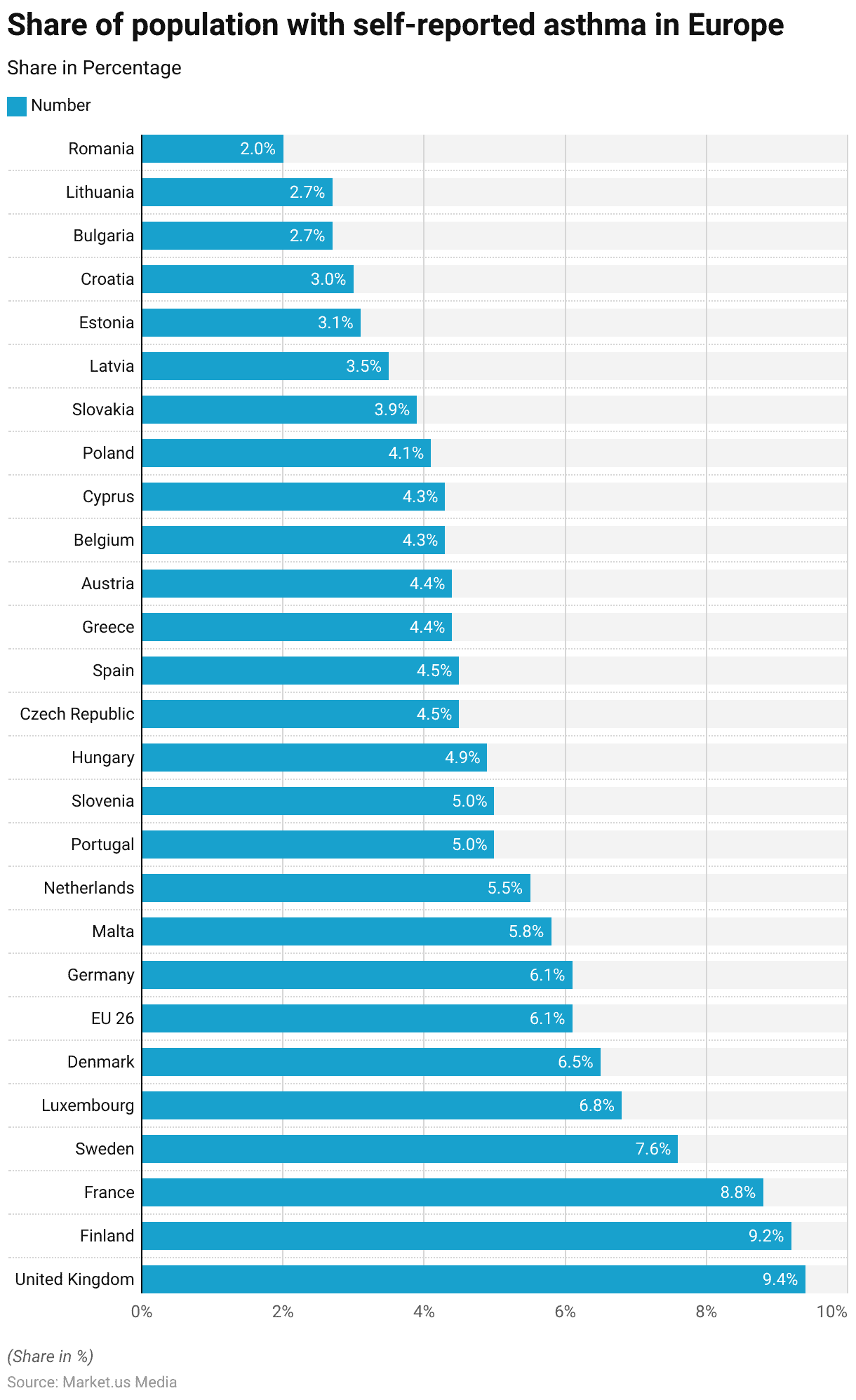
Prevalence of Asthma in Asia-Pacific
- The epidemiology of asthma in Asian children has been thoroughly analyzed using the ISAAC (International Study of Asthma and Allergies in Childhood) survey instrument.
- Findings from ISAAC Phase I indicate that asthma prevalence in the Asia-Pacific region is generally lower than in America, Oceania, or Western Europe. However, there is substantial variation in asthma prevalence among different Asian cities and countries.
- Developed areas like Hong Kong, Japan, and Singapore show higher asthma rates. This aligns with the observed trend that asthma is more prevalent in more developed settings.
- For instance, the prevalence of current wheezing among children aged 13 to 14 years in Hong Kong is notably higher at 12.4%. Compared to mainland Chinese cities such as Beijing (5.1%) and Shanghai (3.3%).
- Furthermore, during the 2009-2011 Asthma Insight and Management survey across 20 countries from five global regions, it was found that complete asthma control, as defined by international criteria, was achieved by only 2% of patients in the Asia-Pacific region—significantly lower than in the United States (29%) and Europe/Canada (16%).
- Additionally, the daily use of controller medications like inhaled corticosteroids is much lower in Asia at 32%, compared to 80% in the United States.
- This underlines the challenges in the region, including suboptimal use of controller treatments and reliance on quick-relief medication and oral steroids.
(Source: Journal of Allergy and Clinical Immunology)
Prevalence of Asthma in Africa
- Asthma prevalence in Africa has been on the rise; it grew from 11.7% of the population (74 million people, including 34.1 million children) in 1990 to 12.8% (119 million, including 49.7 million children) by 2010.
- Despite such high prevalence, data on the burden and determinants of asthma in sub-Saharan Africa remain scarce. The region struggles with myths and stigma associated with asthma, although lessons from high-income countries show these challenges can be overcome.
- In sub-Saharan Africa, asthma is often underdiagnosed and undertreated, leading to a high burden of severe symptoms and mortality rates—for example, Uganda’s asthma mortality rate is 90 times that of the U.K.
- In Uganda, only 33% of asthma patients have controlled asthma, and a significant portion of young children with asthma symptoms are incorrectly diagnosed with pneumonia.
- In Kenya, there’s a notable reluctance to accept an asthma diagnosis, with limited access to medications and a preference for oral over inhaled treatments due to fears about inhaled corticosteroids.
- South Africa, being more affluent, still reports only 31.5% of asthmatic children with well-controlled asthma, with high hospital admission rates.
- Asthma prevalence varies significantly between rural (17%) and urban (21%) settings among adolescents, and though 16.6% have a doctor’s diagnosis, over half exhibit severe symptoms.
(Source: Journal of the Pan-African Thoracic Society)
Asthma Patients – By Age Statistics
- In South Korea in 2022, the distribution of asthma patients treated across different age groups revealed significant variations.
- The youngest group, those under nine years old, had the highest number of patients, totaling approximately 206.45 thousand.
- This number dropped sharply to 51.55 thousand in the 10-19 years age group.
- The numbers then gradually increased across the subsequent age brackets: 57.58 thousand for 20-29 years, 71.09 thousand for 30-39 years, and 86.95 thousand for 40-49 years.
- The 50-59 years age group saw a further increase to 101.84 thousand patients.
- Those aged 60-69 years constituted 133.54 thousand of the treated patients, making them the second largest group.
- The number slightly decreased to 109.16 thousand for the 70-79 years age group and further to 71.85 thousand for those aged 80 years and above.
- These figures highlight a significant burden of asthma among both the very young and the elderly populations in South Korea.
(Source: Statista)
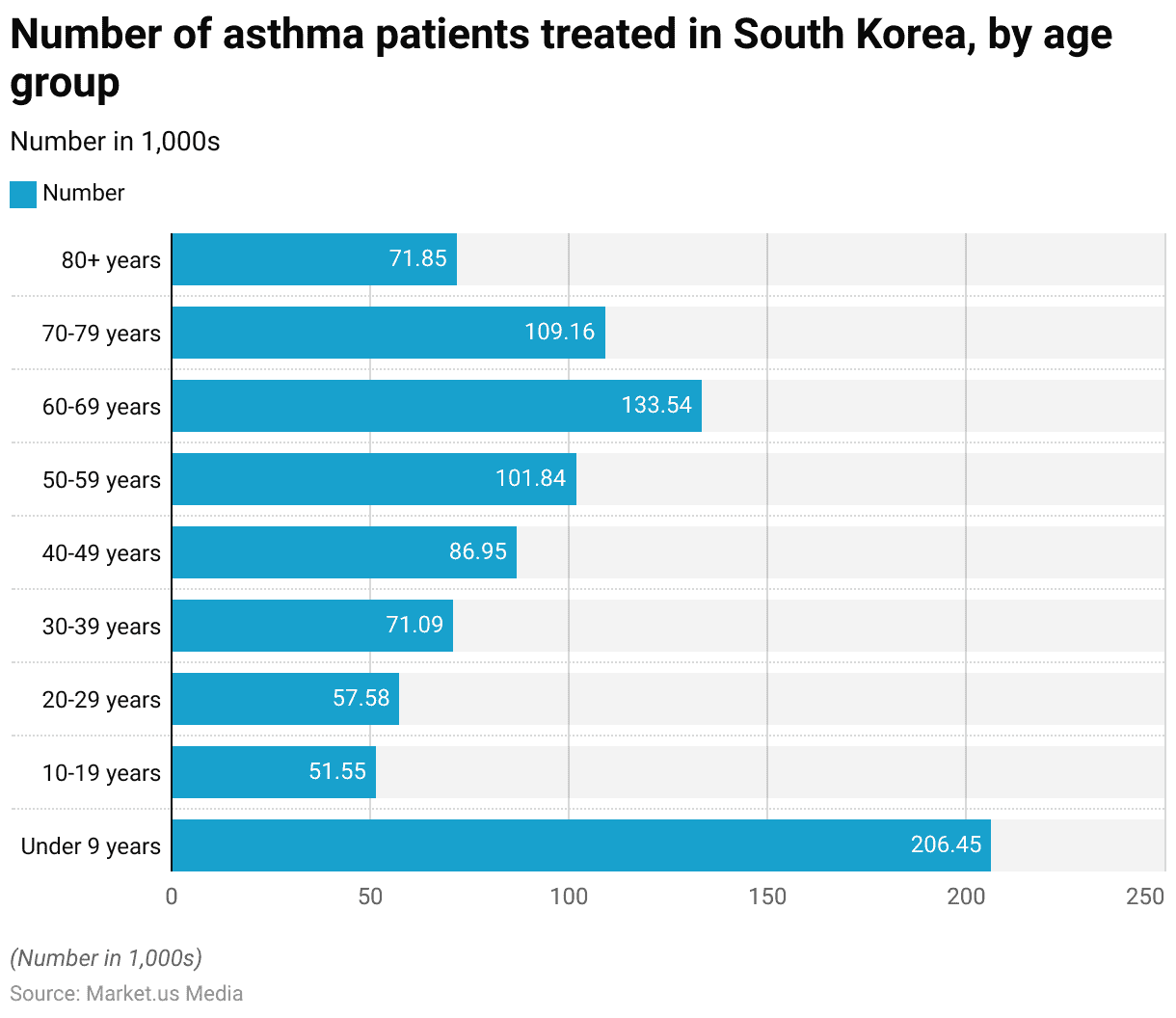
Rate of Asthma Deaths – By Age Statistics
- In the United States in 2021, the rate of deaths due to asthma varied significantly by age group, with the overall rate across all ages standing at 10.6 deaths per million population.
- The youngest groups, ages 5 to 11 and 12 to 17, exhibited the lowest rates at 2.4 and 2.0 deaths per million, respectively.
- Rates increased with age, with the 18 to 24 age group experiencing a rate of 3.8 and those aged 25 to 34 at 6.4.
- The rate continued to climb for the 35 to 64 age group, reaching 11.5 deaths per million.
- The highest rate was observed in those aged 65 and over, at 27.1 deaths per million, reflecting the increased vulnerability of the elderly population to asthma-related fatalities.
(Source: Statista)
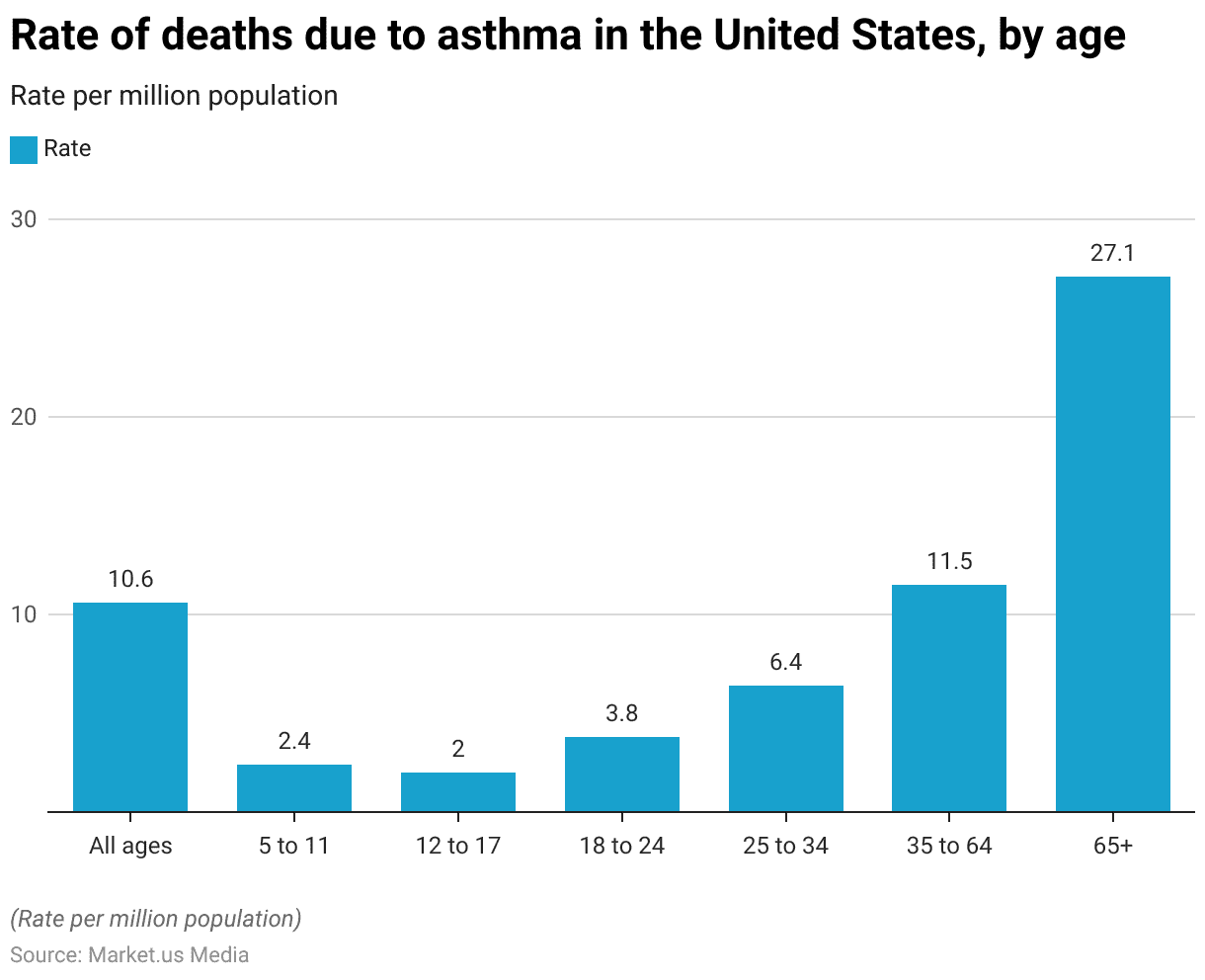
Asthma Attacks – By Age Statistics
- In 2020, the proportion of individuals in the U.S. with asthma who reported experiencing one or more asthma attacks over the previous 12 months demonstrated noticeable differences across age groups.
- Overall, 40.70% of those with asthma across all ages experienced an attack.
- Breaking it down by age, adults aged 18 and older saw a slightly higher percentage of 41%, while 42.70% of children aged 0-17 experienced attacks.
- The highest frequency of attacks was among the youngest children, ages 0-4, with 52.90% reporting attacks.
- Children aged 5 to 14 had attacks at a rate of 45.10%.
- Adolescents aged 15 to 19 had the lowest reported rate of attacks at 29.10%, which then increased to 34.70% for young adults aged 20 to 24.
- Individuals in the 25 to 34 age range saw a rate of 42.20%, and the rate peaked again at 46.40% for those aged 35 to 64.
- Older adults aged 65 and over reported a lower rate of 31.80%.
- These statistics underscore the variability in asthma attack prevalence related to different life stages in the U.S. asthmatic population.
(Source: Statista)
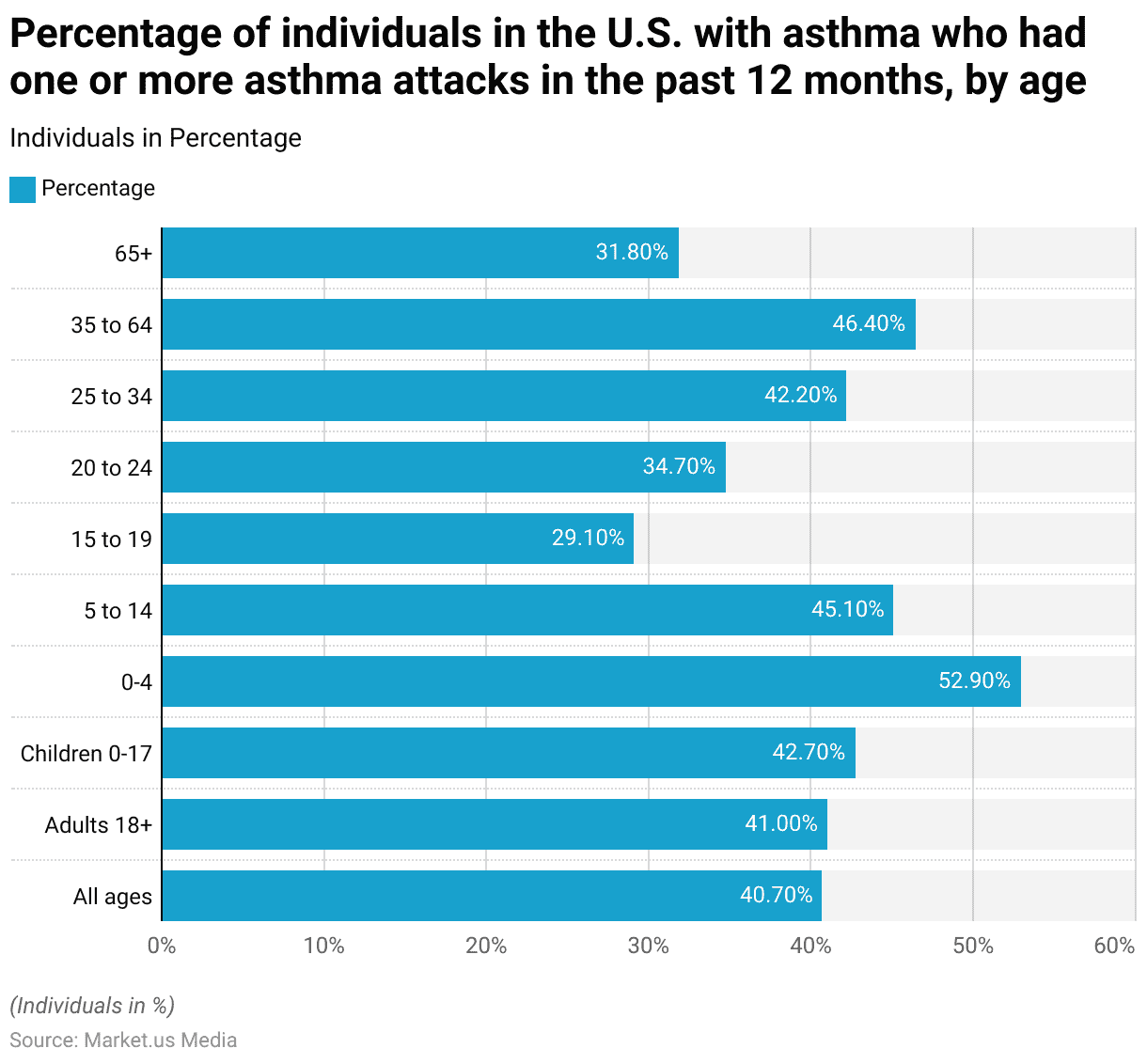
Emergency Hospital Admissions for Asthma – By Age Statistics
- During the 2013 to 2014 period in the United Kingdom, the number of emergency hospital admissions for asthma varied notably across different age groups.
- The highest number of admissions was observed in the youngest group, children aged 0-9 years, with a total of 16,152 admissions.
- Adolescents aged 10-19 years accounted for 7,011 admissions.
- In the adult age groups, there were 5,635 admissions for those aged 20-29 years, 5,189 for the 30-39 years group, and 6,282 for those aged 40-49 years.
- The number of admissions decreased with advancing age, with 4,988 admissions for those aged 50-59 years, 3,371 for the 60-69 years group, 2,989 for individuals aged 70-79 years, and 2,681 for those aged 80 years and older.
- This data highlights a significant impact of asthma across all ages, with a marked decline in emergency admissions as age increases, especially beyond 50 years.
(Source: Statista)
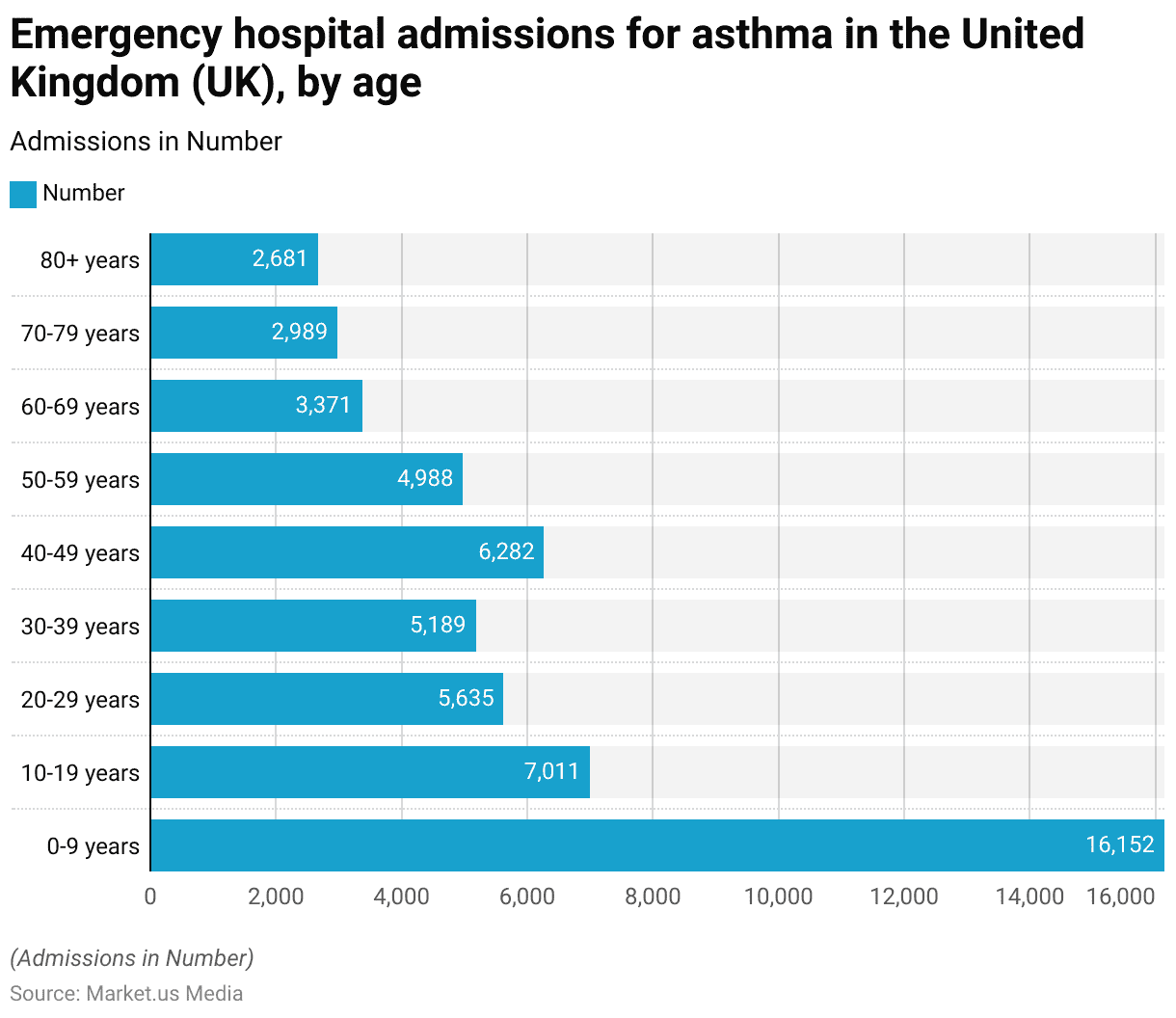
Cases of Asthma in Senior Citizens Statistics
- The number of asthma cases among senior citizens in India has been projected to increase significantly over several decades, from 2011 to 2050.
- In 2011, 8 million cases were recorded among this demographic.
- By 2015, this number had risen to 9 million.
- The trend continued upward, reaching 10.7 million cases by 2020.
- Projections for future decades indicate a substantial increase, with 14.7 million cases expected by 2030 and a sharp rise to 25.4 million by 2050.
- This data underscores a growing health challenge among India’s aging population, highlighting the need for enhanced asthma management and healthcare resources to accommodate this increase.
(Source: Statista)

Current Asthma Prevalence – By Gender Statistics
- From 2001 to 2021, the percentage of people with current asthma in the United States exhibited fluctuations across genders.
- In 2001, 8.30% of females and 6.30% of males were reported to have asthma.
- The percentages varied over the years, with both genders showing a general upward trend in the early 2010s.
- The highest rates were observed in 2016 for females at 9.70% and in 2011 for males at 7.20%.
- Notably, female rates consistently surpassed those of males throughout the two decades.
- By 2020, the percentage reached a peak for females at 9.50%, while males had a lower peak at 6.10%.
- The most recent data from 2021 shows a slight decrease to 8.90% for females and 6.50% for males.
- This long-term data reflects persistent higher prevalence rates of asthma among females compared to males in the U.S.
(Source: Statista)
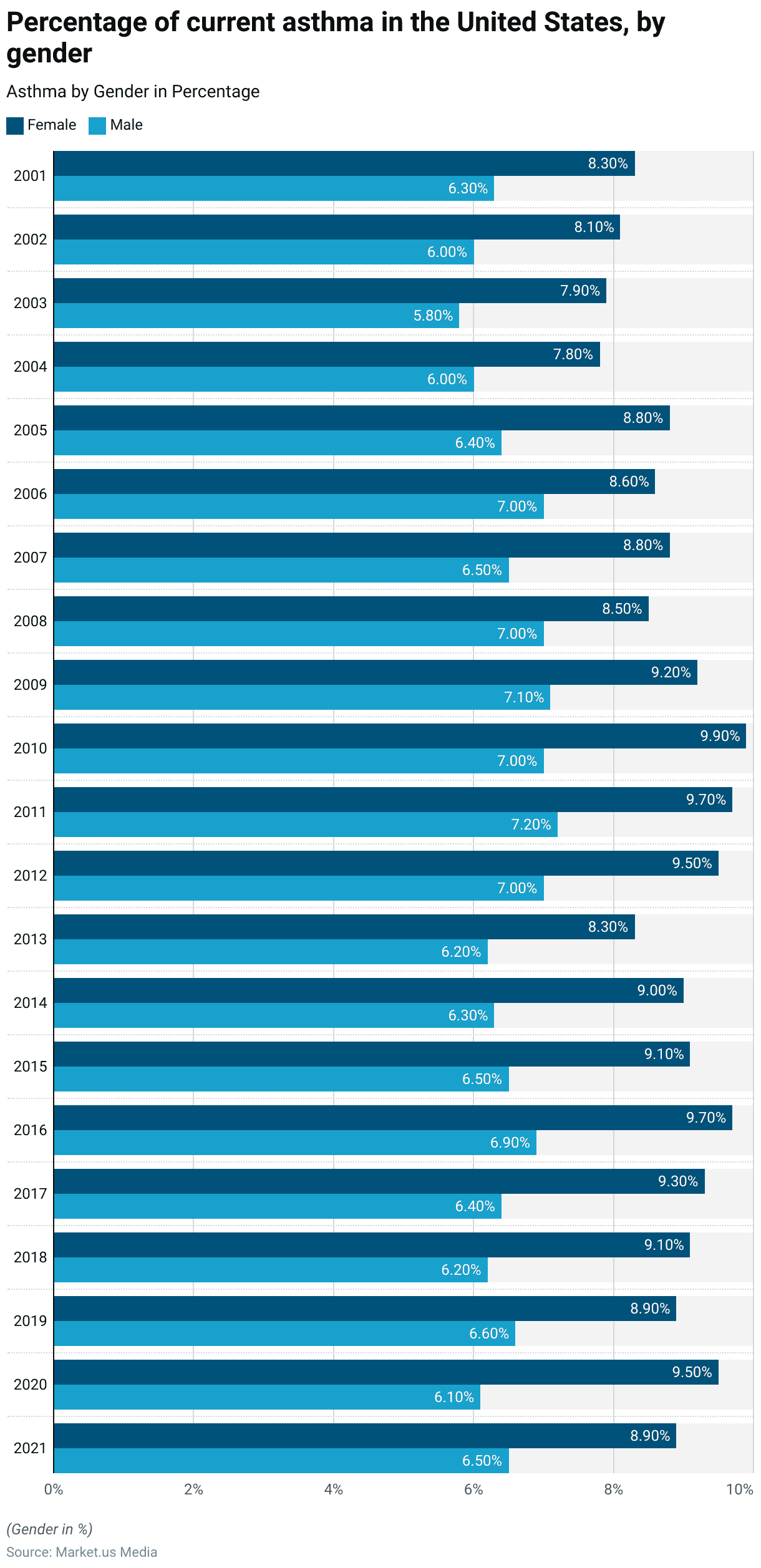
Individuals Diagnosed with Asthma – By Gender and Age Statistics
- In Spain during the year 2020, the diagnosis of asthma among different age groups showed significant gender differences in the number of individuals affected, with a total counted in thousands.
- For the younger age group of 15-24 years, men diagnosed with asthma numbered approximately 108.3 thousand compared to 102.9 thousand women.
- The disparity grew in the 25-34 years age group, where women diagnosed were substantially higher at 159.6 thousand, compared to men at 110 thousand.
- The trend continued with men at 127.8 thousand and women at 137.1 thousand in the 35-44 years bracket.
- In the 45-54 years age group, women diagnosed with asthma increased to 153.8 thousand versus 111.2 thousand men.
- The numbers started to decrease in older age groups but still showed higher numbers for women, with 138.2 thousand women versus 65 thousand men in the 55-64 years bracket.
- This pattern persisted into older age, with 101.6 thousand women and 75.1 thousand men in the 65–74 years group and 81.7 thousand women compared to 54.9 thousand men in the 75-84 years group.
- The gap was most pronounced in the oldest group, 85 years and older, where women numbered 65 thousand compared to only 17.5 thousand men.
- This data highlights a generally higher incidence of asthma among women across almost all age groups in Spain.
(Source: Statista)
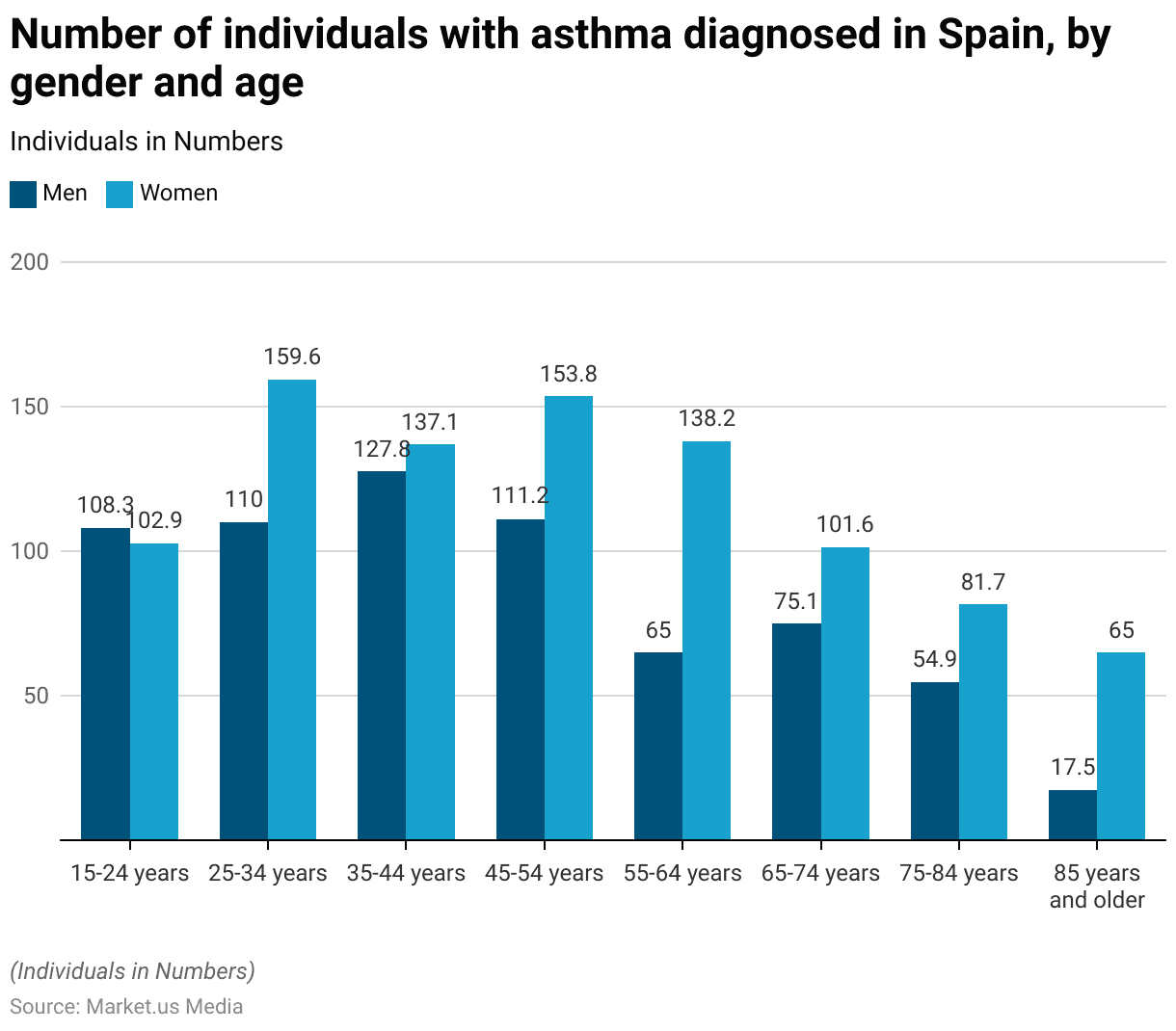
Asthma Attacks – By Gender Statistics
- In 2020, in the United States, the percentage of individuals with asthma who experienced one or more attacks in the previous 12 months varied between genders and age groups.
- Overall, 37.50% of males and 43.10% of females reported having an asthma attack.
- Among adults aged 18 and older, the percentages were slightly lower, with 36.60% of males and 42.90% of females experiencing asthma attacks.
- The incidence was higher among children aged 0-17, where 40.80% of males and 44.50% of females reported asthma attacks.
- This data indicates that females, both adults and children, are more likely than their male counterparts to experience asthma attacks in the U.S.
(Source: Statista)

Asthma Incidence Rate – By Age and Gender Statistics
- In 2019, Poland recorded differing asthma incidence rates across various age groups and by gender per 100,000 population.
- For children aged 0-5 years, men had a higher incidence rate at 8.50% compared to 5.80% for women.
- This trend reversed in older children, with boys aged 6-10 years showing a higher rate at 15.20%, significantly above the 10.60% for girls in the same age group.
- The pattern continued in the 11-17 age group, with 9.70% for men and 6.40% for women.
- However, in adults aged 18-40 years, the incidence was lower and more balanced between genders, at 2.90% for men and slightly higher at 3.30% for women.
- The rate for the 41-55 years age group stood at 2.90% for men and 4.70% for women, showing a greater disparity.
- Among those aged 56-70 years, women had a significantly higher rate at 7.50% compared to 4.60% for men.
- This trend was also observed in the elderly aged 71 years and older, where women had an incidence rate of 8.40%, higher than 7.20% for men, reflecting an overall higher asthma incidence in women, particularly in older age groups.
(Source: Statista)
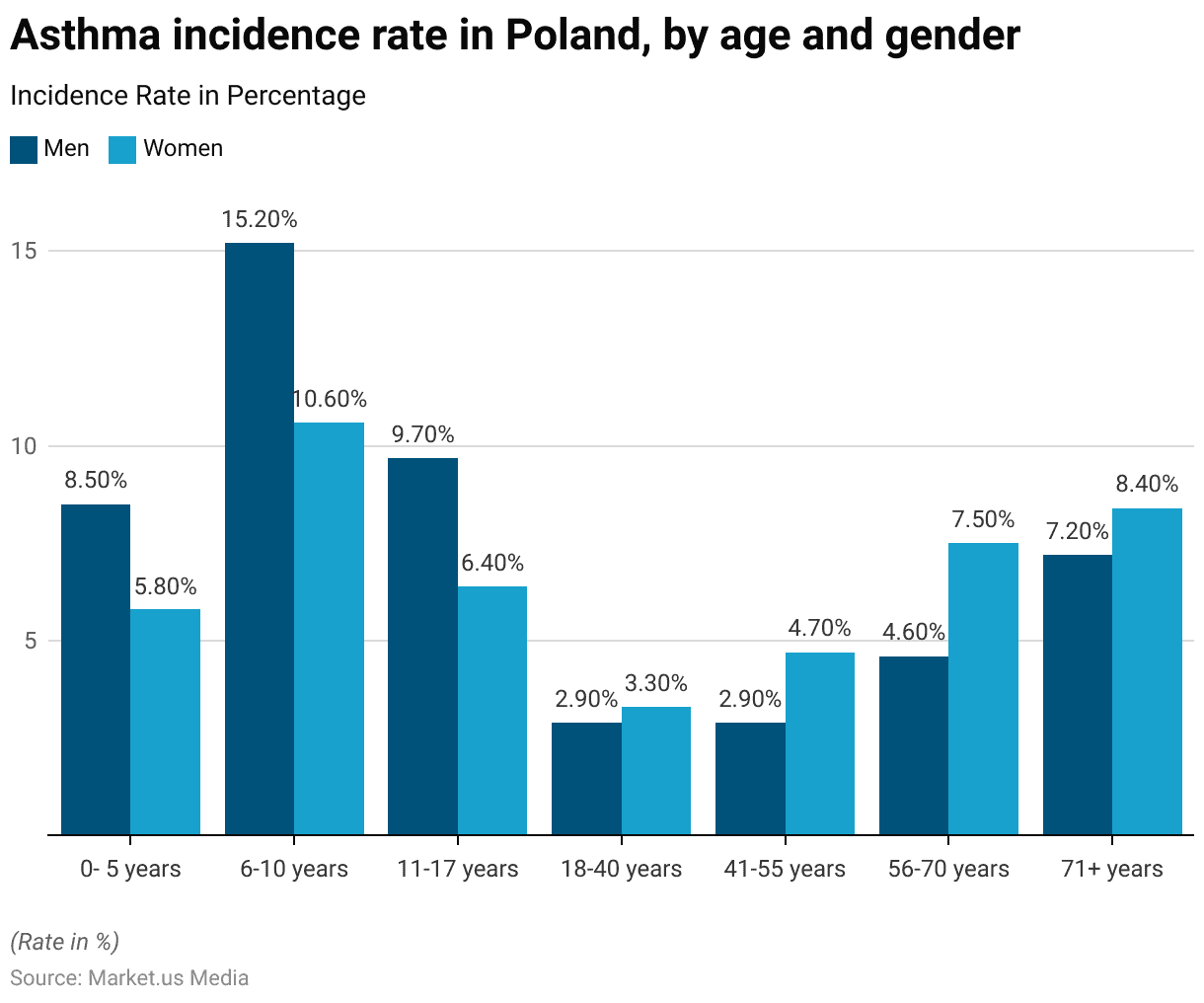
Deaths with Asthma as Underlying Cause – By Gender Statistics
- From 2018 to 2022, the rate of deaths in the U.S. with asthma as the underlying cause showed gender differences and fluctuations over the years, measured per 100,000 population.
- In 2018, the rate for males was 0.7, and for females, it was higher at 0.9.
- The following year, 2019, saw an increase to 0.8 for males and 1 for females.
- The rate continued to rise into 2020, reaching 0.9 for males and peaking at 1.1 for females.
- However, there was a slight decrease in 2021, with the rates reverting to 0.8 for males and stabilizing at 1 for females.
- By 2022, the rate for males decreased back to 0.7, while the rate for females remained constant at 1.
- Throughout this period, females consistently had a higher mortality rate from asthma compared to males.
(Source: Statista)
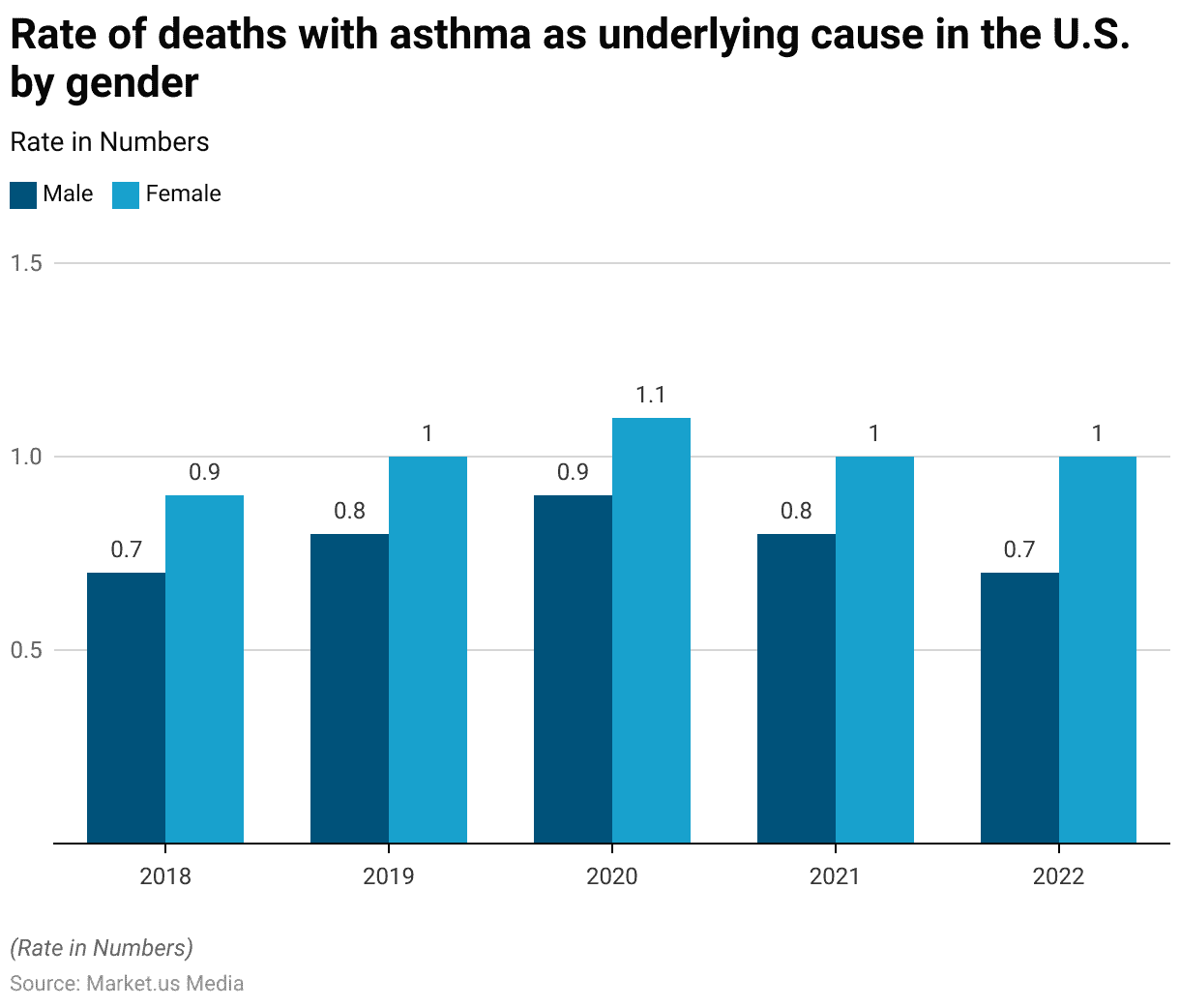
Current Asthma Prevalence – By Age, Gender, and Ethnicity Statistics
- In the United States in 2021, the prevalence of current asthma exhibited variations across different demographic groups.
- Among children under the age of 18, the prevalence was 6.50%. In contrast, adults experienced a higher prevalence rate of 8%.
- When analyzed by gender, males had an asthma prevalence of 6.50%, while females reported a higher rate of 8.90%.
- Racial and ethnic disparities were also evident: White, non-Hispanic individuals had a prevalence of 7.60%, but Black, non-Hispanic individuals faced a significantly higher prevalence of 10.90%.
- Hispanic individuals had the lowest reported rate at 6.40%.
- These statistics highlight the differences in asthma prevalence associated with age, gender, and race/ethnicity in the U.S.
(Source: Statista)

Trends in Asthma Prevalence by Race and Ethnicity Statistics
- From 2009 to 2021, the prevalence of current asthma among various racial and ethnic groups in the United States exhibited specific trends.
- White non-Hispanic individuals consistently showed an asthma prevalence ranging from 7.4% to 8.3%, with a slight decrease in recent years, stabilizing at 7.7% in 2020 and 2021.
- Black non-Hispanic individuals experienced higher prevalence rates throughout the years, peaking at 12.1% in 2010 and gradually decreasing to 11% by 2021.
- The rates for individuals identified as Other Non-Hispanic fluctuated, reaching a high of 8.4% in 2011 before settling at 7.1% in the latest years.
- Hispanic individuals generally reported the lowest prevalence rates. Which oscillated between 5.7% and 7.3%, ending at 5.7% in 2021.
- This data highlights notable disparities in asthma prevalence across different racial and ethnic groups over more than a decade.
(Source: Statista)
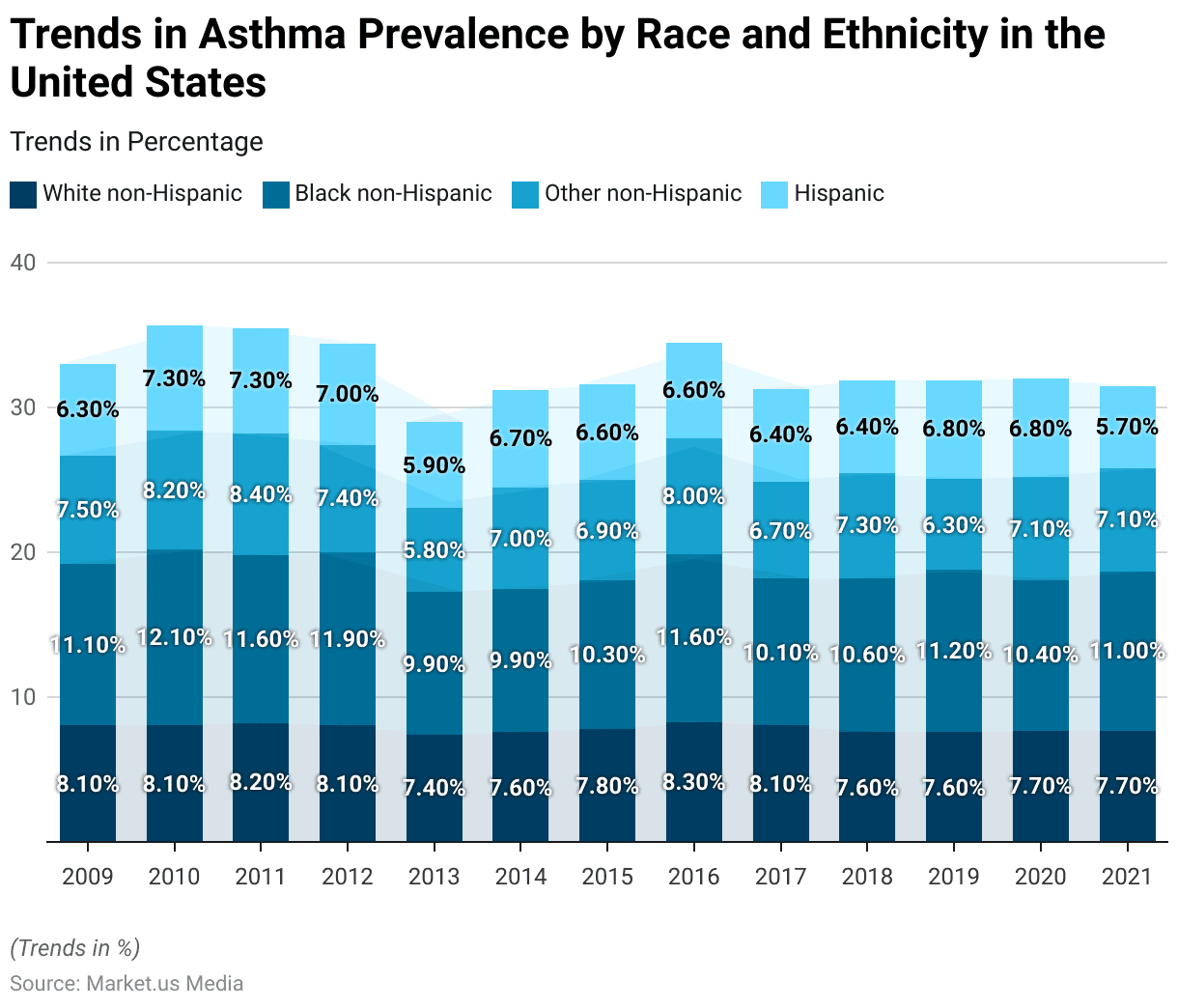
Asthma Attacks in Children – By Race/Ethnicity Statistics
- Between 2019 and 2021 in the United States, the percentage of children with asthma who experienced one or more asthma attacks over the past 12 months varied significantly by race and ethnicity.
- American Indian or Alaska Native children who are non-Hispanic had the highest rate of asthma attacks at 47.90%.
- This was followed closely by Asian non-Hispanic children at 43.30% and White non-Hispanic children at 42.70%.
- Hispanic children also had a notable percentage at 41.20%. While Mexican children had a slightly lower rate of 40.10%.
- Black non-Hispanic children had the lowest reported rate of asthma attacks at 39.30%.
- These statistics indicate diverse experiences with asthma attacks among different racial and ethnic groups within the pediatric population in the U.S.
(Source: Statista)
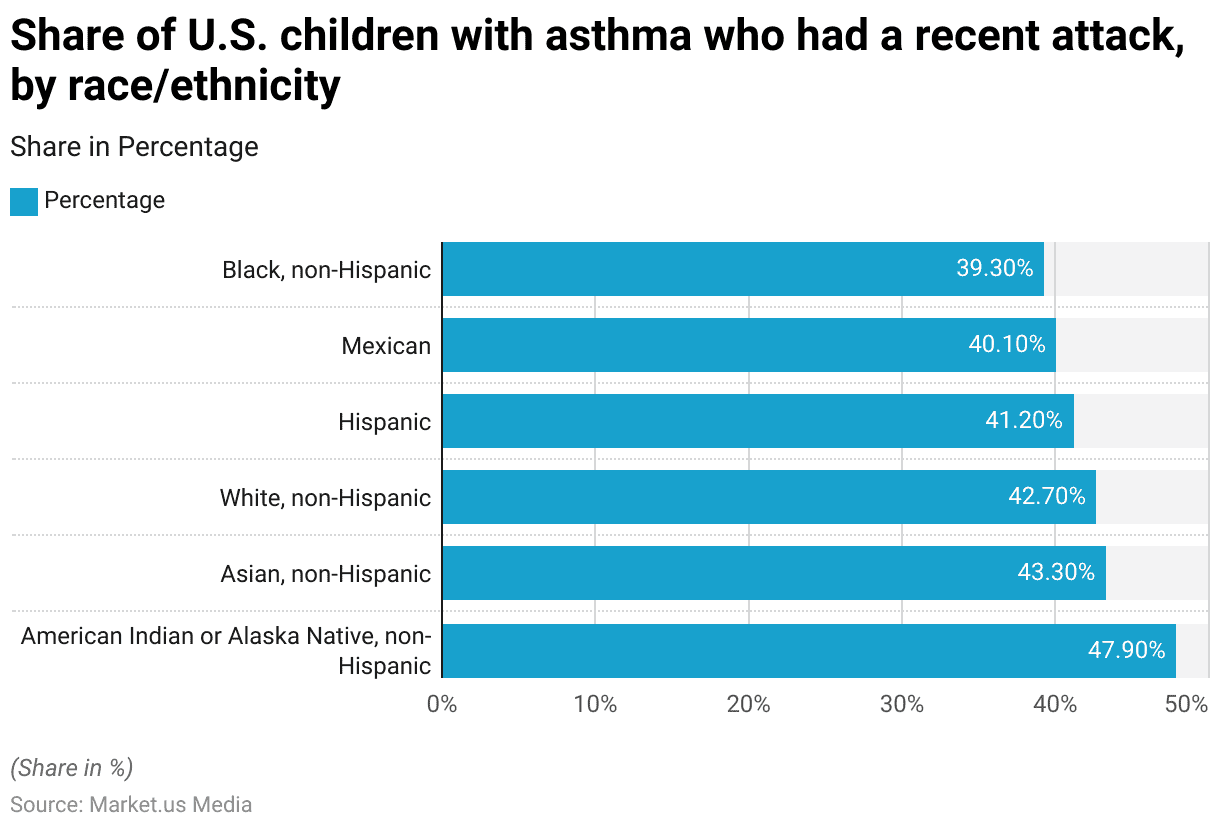
Asthmatic Children That Visited an ED/UC – By Ethnicity
- In 2016, the emergency department or urgent care (ED/UC) visitation rates for asthma among U.S. children aged 0-17 years exhibited notable differences across various ethnicities.
- White non-Hispanic children had the lowest rate of ED/UC visits at 12.20%.
- In contrast, Black non-Hispanic and Other non-Hispanic children experienced much higher visitation rates at 22.50% and 22.10%, respectively.
- Hispanic children had a moderately high rate of 16.20%, with specific differences within this group:
- Puerto Rican children had a significantly lower rate of 8.80%, whereas Mexican/Mexican-American children had a rate of 16%.
- All other Hispanic children faced the highest rate of ED/UC visits at 24.10%.
- These statistics underscore the disparities in emergency healthcare utilization among asthmatic children from different ethnic backgrounds in the U.S.
(Source: Statista)
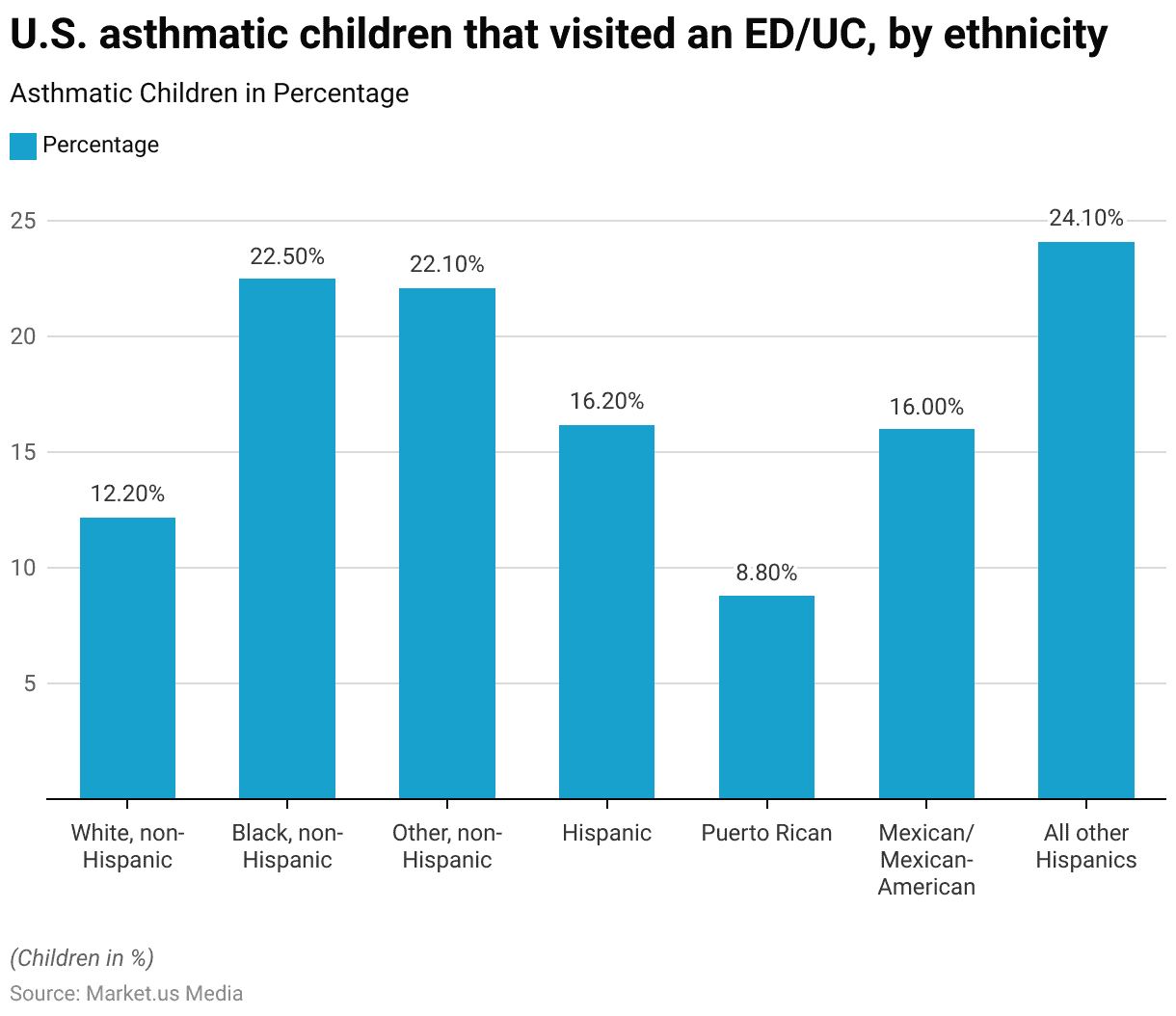
Asthma Death Rate – By Ethnicity
- From 1999 to 2016, the asthma death rates among U.S. residents showed significant disparities across different ethnic groups, calculated per one million population.
- American Indian or Alaska Native individuals who are non-Hispanic experienced a death rate of 7.75, while Asian or Pacific Islanders had the lowest rate at 4.92.
- In stark contrast, Black or African American individuals faced the highest death rate at 25.6.
- White individuals had a rate of 6.52, slightly below the rate for Hispanic or Latino individuals, which stood at 5.96.
- Not Hispanic or Latino individuals had a death rate of 9.39, indicating a higher asthma-related mortality compared to most Hispanic groups but lower than the rate for Black or African Americans.
- These figures highlight significant racial and ethnic disparities in asthma mortality within the U.S. over the studied period.
(Source: Statista)
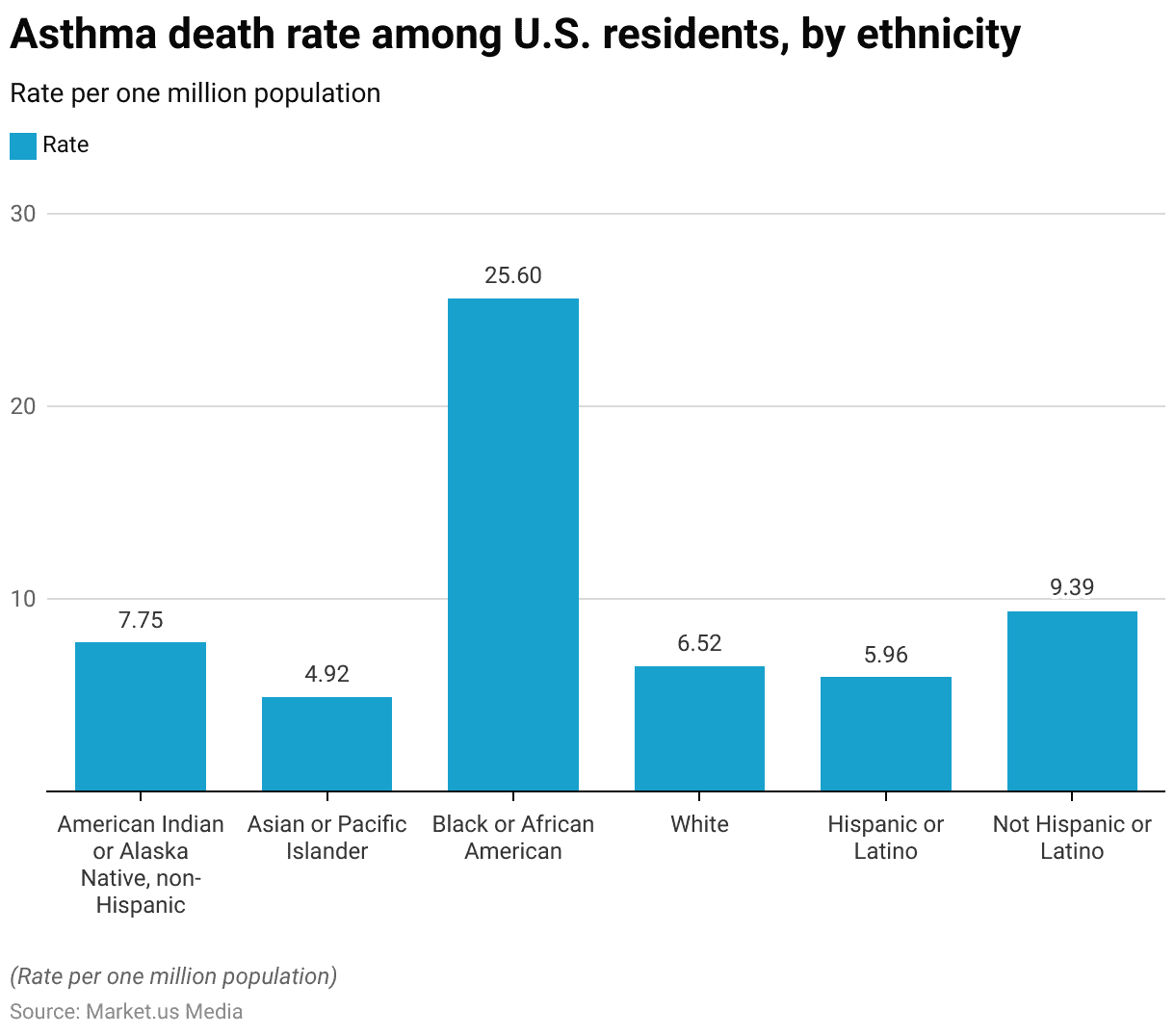
Asthma Treatment Statistics
Global Asthma Treatment Market Size
- The global asthma treatment market is projected to experience steady growth from 2023 through 2033 at a CAGR of 3.9%.
- Starting in 2023, the market size is estimated to be USD 26.1 billion.
- It is expected to increase annually, reaching USD 27.1 billion in 2024 and further growing to USD 28.2 billion by 2025.
- The upward trend continues, with the market size hitting USD 29.3 billion in 2026, USD 30.4 billion in 2027, and USD 31.6 billion by 2028.
- Significant growth is projected in the subsequent years, with the market size reaching USD 32.8 billion in 2029, USD 34.1 billion in 2030, and USD 35.4 billion by 2031.
- The growth trajectory is set to continue, with market sizes of USD 36.8 billion and USD 38.3 billion expected for 2032 and 2033, respectively.
- This steady increase reflects ongoing advancements and growing demand for asthma treatments globally.
(Source: market.us)
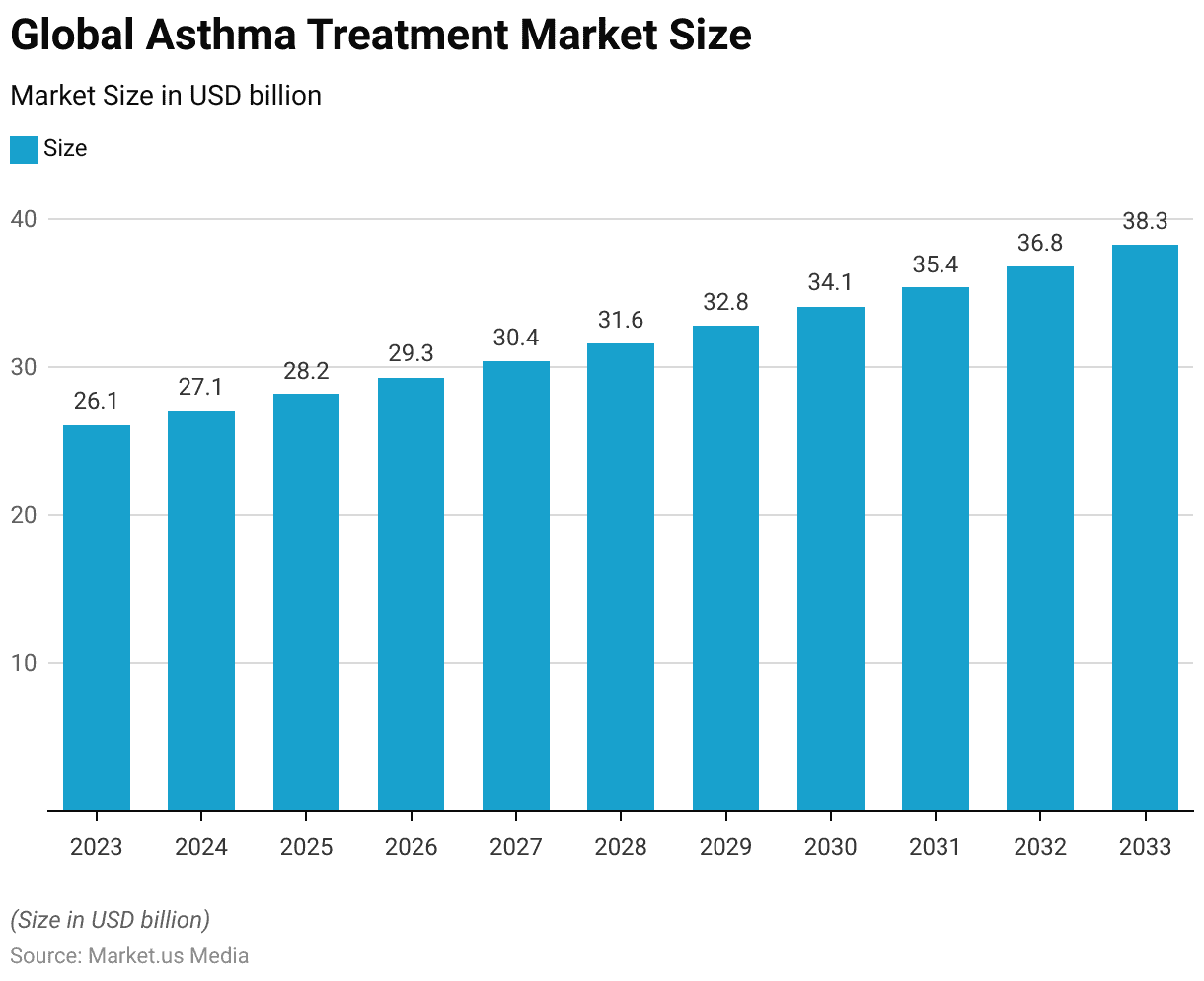
Global Asthma & COPD Drugs Market Size
- The global market for Asthma & COPD Drugs is expected to see considerable growth over the next decade, starting from 2023 through 2033, at a CAGR of 5.6%.
- In 2023, the market is forecasted to be valued at USD 38.2 billion.
- It is projected to grow steadily each year, reaching USD 40.3 billion in 2024, USD 42.4 billion in 2025, and continuing to rise to USD 44.7 billion in 2026.
- The growth trajectory maintains momentum, with the market size expected to increase to USD 47.1 billion in 2027 and USD 49.7 billion in 2028.
- By the end of the decade, in 2029, the market is anticipated to reach USD 52.4 billion.
- Heading into the next decade, the market is likely to expand to USD 55.2 billion in 2030, USD 58.2 billion in 2031, and USD 61.3 billion in 2032.
- By 2033, the market is projected to grow to USD 64.6 billion.
- This upward trend reflects a strong and ongoing demand for asthma and COPD treatment options globally.
(Source: market.us)

Treatment of Asthma Among Adults – By Type
- The treatment of asthma among adults in the United States showed notable changes between the periods 1998-1999 and 2008-2009.
- The use of controller medications increased from 54.30% in 1998-1999 to 59.90% in 2008-2009.
- Similarly, the usage of Inhaled Corticosteroids (ICS) saw a significant rise from 39.90% to 51.20% over the same period.
- The adoption of Leukotriene Receptor Antagonists (LTRAs) also increased, growing from 12.40% to 20.40%.
- However, the overall use of any reliever medication decreased slightly, from 67.70% to 61.70%.
- The percentage of adults using reliever medications only remained relatively stable, shifting marginally from 26.80% to 26.10%.
- Oral corticosteroid (OCS) usage also saw a decrease from 13.70% in the earlier period to 12.40% in the later period.
- These trends highlight the evolving landscape of asthma management in the U.S., with a notable shift towards more preventive measures over the decade.
(Source: Statista)
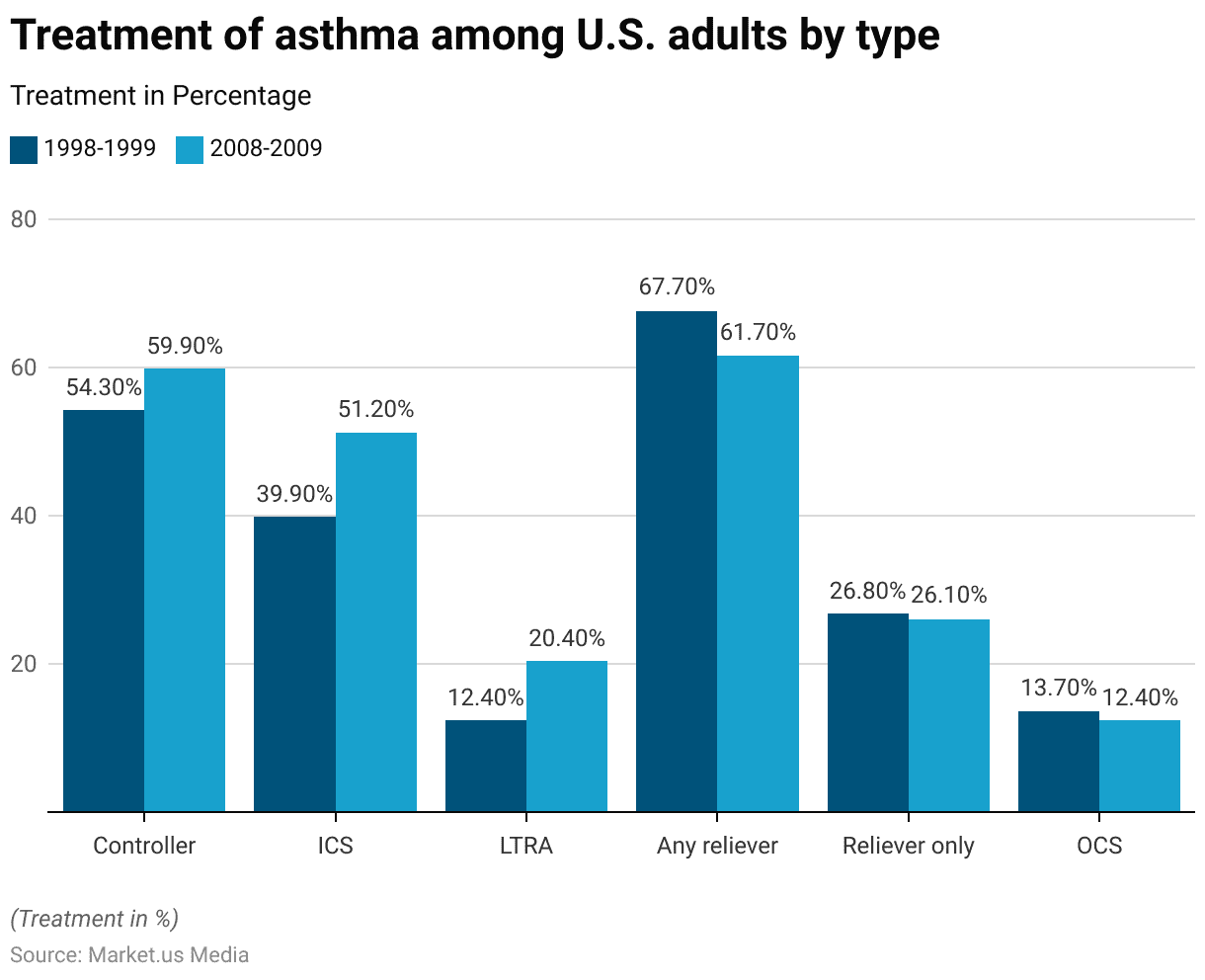
Top Asthma Medicines Sold Worldwide
- In 2018, the top 10 asthma medications by revenue showcased significant contributions from major pharmaceutical companies, tallying billions in U.S. dollars.
- Leading the pack was Seretide/Advair from GlaxoSmithKline, generating $3.22 billion.
- Following closely was another GlaxoSmithKline product, Ellipta, with revenues of $2.73 billion. AstraZeneca’s Symbicort also performed well, bringing in $2.56 billion.
- Xolair, produced by Roche and Novartis, earned $1.91 billion.
- Another AstraZeneca medication, Pulmicort, generated $1.29 billion, while Ventolin, yet another GlaxoSmithKline product, achieved revenues of $0.98 billion.
- Flixotide/Flovent from GlaxoSmithKline, Nucala/Mepolizumab from the same company, and Singulair from Merck & Co. contributed $0.79 billion, $0.75 billion, and $0.71 billion, respectively.
- Lastly, Fasenra from AstraZeneca rounded out the list with $0.3 billion.
- These figures reflect the substantial financial impact and market presence of these leading asthma therapies in 2018.
(Source: Statista)
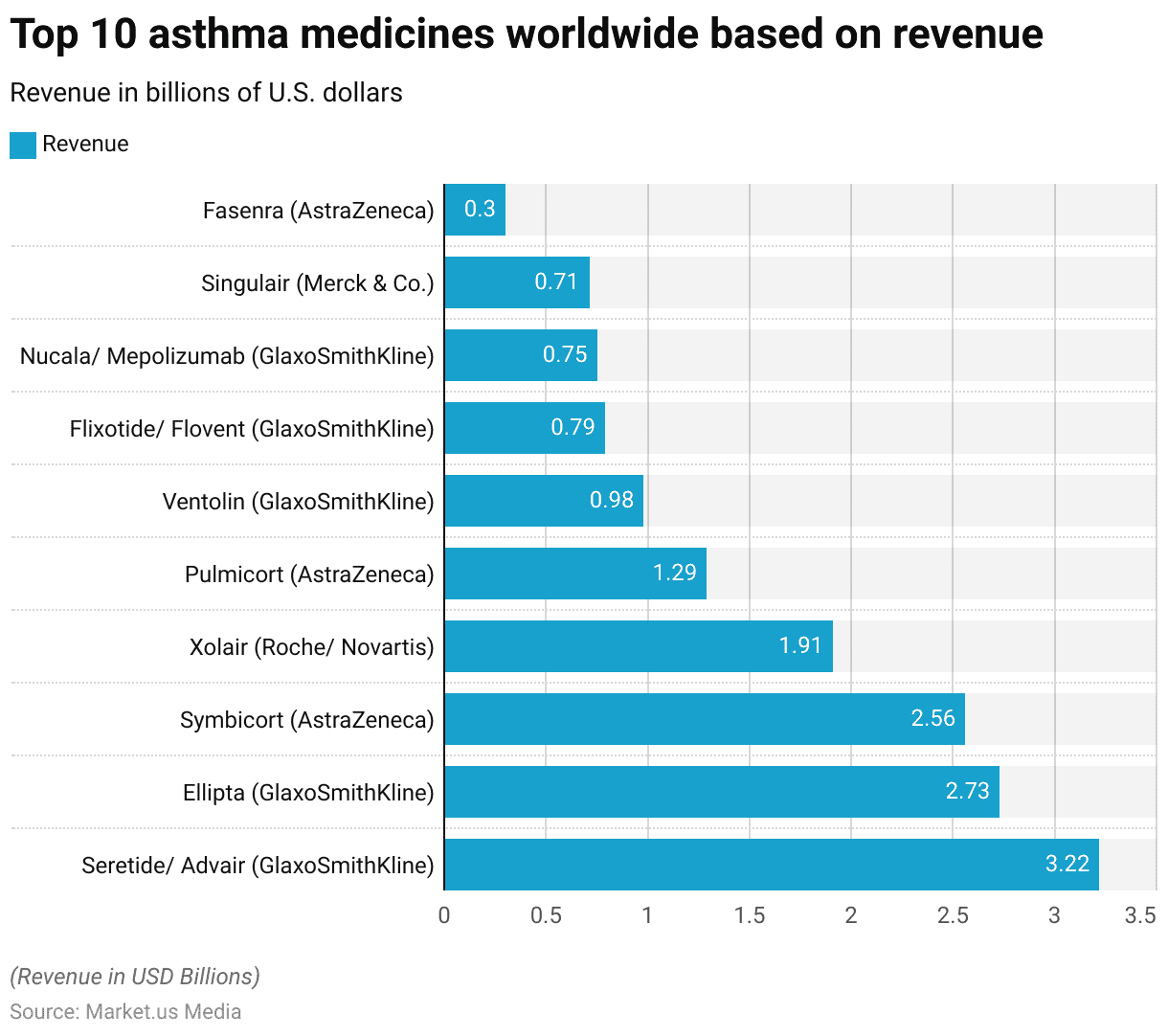
Dispensed Asthma/COPD Medicines
- From 2014 to 2023, the Netherlands saw a noticeable trend in the number of dispensed asthma/COPD medications.
- In 2014, approximately 71.34 million medications were dispensed, which slightly decreased to 71.22 million in 2015 and continued a gradual decline to 71.09 million in 2016.
- The decrease became more pronounced over the following years, with the number dropping to 70.47 million in 2017, 70.24 million in 2018, and 69.65 million in 2019.
- The trend of declining dispensation accelerated notably in 2020, with 68.35 million medications, and the number further decreased to 64.01 million in 2021.
- However, a slight increase was observed in 2022, with 64.86 million medications dispensed, and the number remained relatively stable in 2023, with 64.83 million.
- This overall decline over the decade indicates a significant shift in the dispensation patterns of asthma and COPD medicines in the Netherlands.
(Source: Statista)
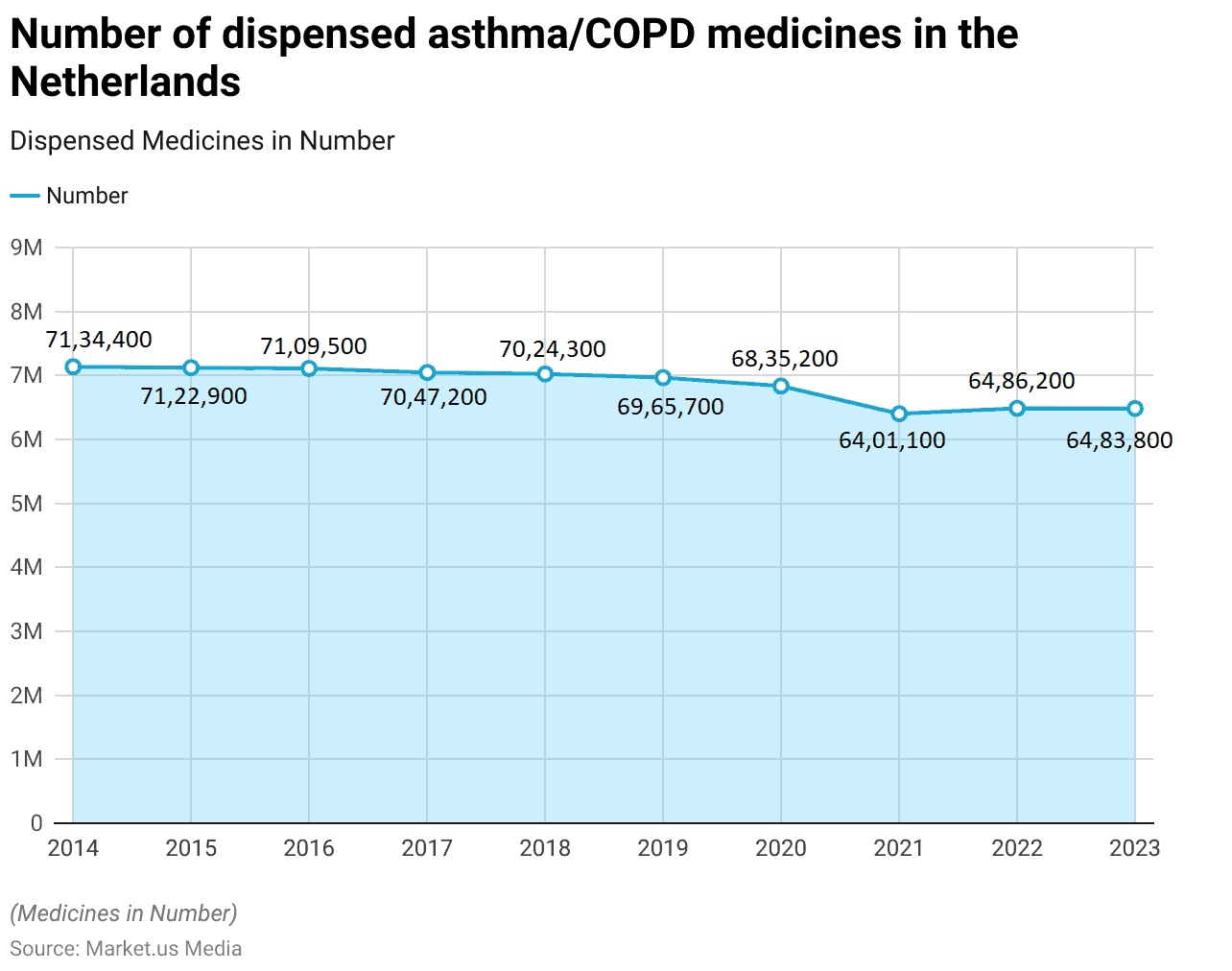
Users of COPD and Asthma Medication
- Between 2008 and 2021, Norway experienced fluctuations in the number of users per 100,000 inhabitants taking COPD and asthma medications.
- In 2008, the figure was 93 users per 100,000 inhabitants, which incrementally rose to 96 by 2009 and continued a steady growth each year, reaching 97 in 2010 and 98 in 2011.
- By 2012, the number reached 100 users per 100,000 and continued to grow slightly each year, achieving 101 in 2013 and 102 in 2014.
- A more noticeable increase occurred from 2015 onwards, with the numbers climbing to 105 in 2015, 108 in 2016, and peaking at 113 in 2019.
- However, a slight decline was observed in the following years, dropping to 111 in 2020 and further decreasing to 109 in 2021.
- This trend reflects a gradual but significant increase in medication users over the 13 years, despite the slight decline at the end of the period.
(Source: Statista)

Albuterol Prescriptions
- From 2004 to 2021, the number of albuterol prescriptions in the U.S. demonstrated various trends, with an overall upward trajectory over the years, measured in millions.
- The count started at 37.56 million in 2004 and slightly increased to 37.6 million in 2005. It then rose to 41.27 million by 2006, followed by a dip to 36.58 million in 2007.
- The number picked up again, reaching 39.27 million in 2008 and continuing to grow to 41.73 million in 2009. The prescriptions experienced a significant jump in 2010, peaking at 48.71 million.
- Although there was a slight decrease in the following years to 45.99 million in 2011 and further to 44.17 million in 2012, the numbers rebounded to 46.33 million in 2013.
- They continued to climb, reaching 48.19 million in 2014 and 49.75 million in 2015 and fluctuating slightly to 47.11 million in 2016.
- A notable increase was seen from 2017 onwards, with prescriptions rising to 50.29 million and then surging in 2018 to 60.53 million.
- This upward trend persisted through 2019 and 2020, with prescriptions slightly increasing to 60.68 million and 61.95 million, respectively, and slightly declining to 61.47 million in 2021.
- This period marked significant growth in the usage of albuterol, reflecting changes in medical practices, healthcare policies, or population health dynamics.
(Source: Statista)
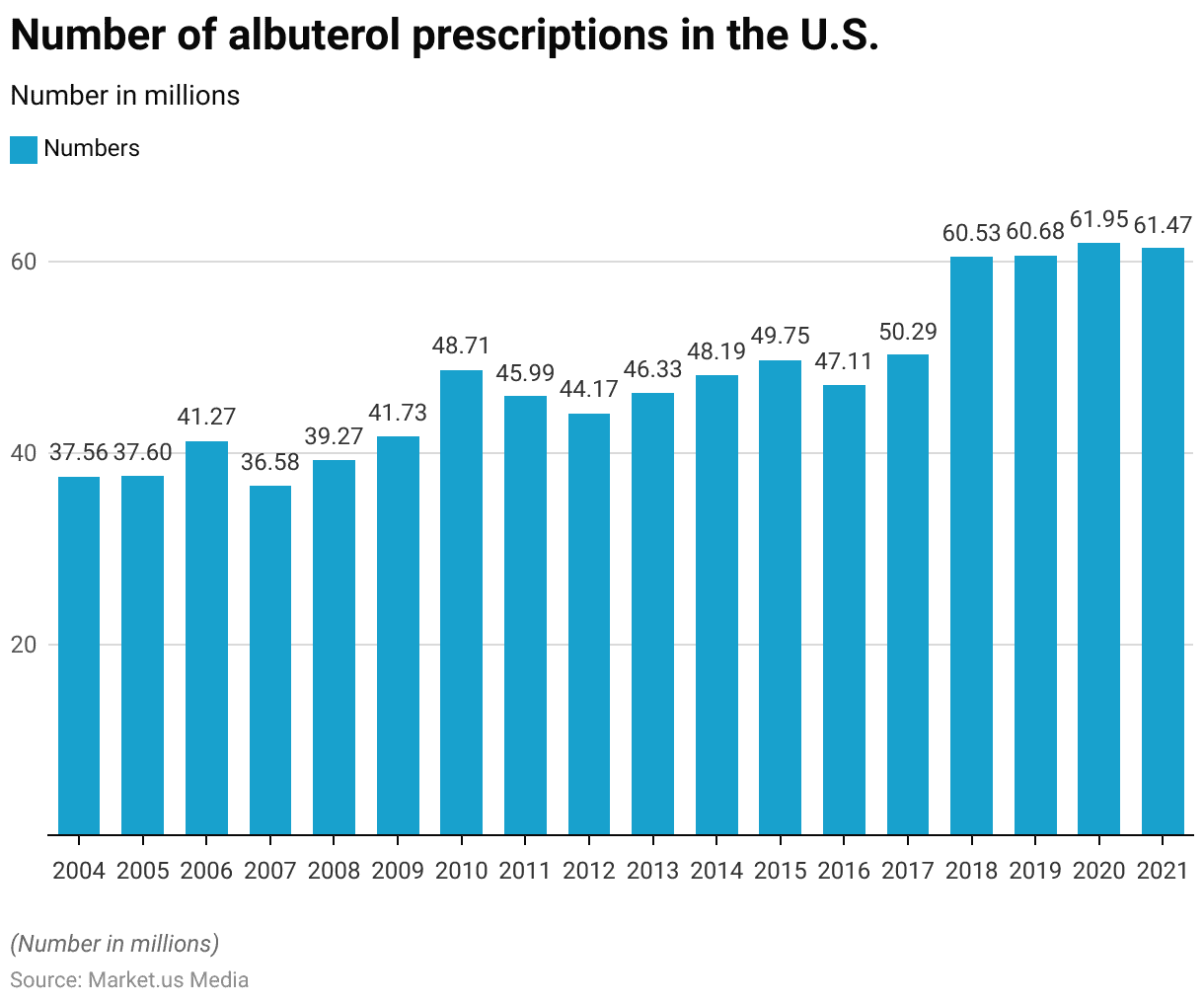
Spending and Investments in Asthma Treatment
User Out-Of-Pocket Expenditure On Major Types of Asthma Medications
- In the United States, the annual out-of-pocket expenditure per user for major types of asthma medications experienced varied changes between the periods 1998-1999 and 2008-2009.
- For all therapeutic classes combined, expenditure slightly increased from $227 in 1998-1999 to $235 in 2008-2009.
- Expenditure on controller medications showed a minimal rise from $238 to $239 over the same period.
- However, there was a more noticeable increase in spending on relievers, which went up from $82 to $99.
- In contrast, spending on oral corticosteroids saw a significant decrease, halving from $23 in the earlier period to just $10 in the later period.
- These figures reflect shifts in asthma medication usage patterns and possibly the effects of changes in healthcare policy or drug pricing over the decade.
(Source: Statista)
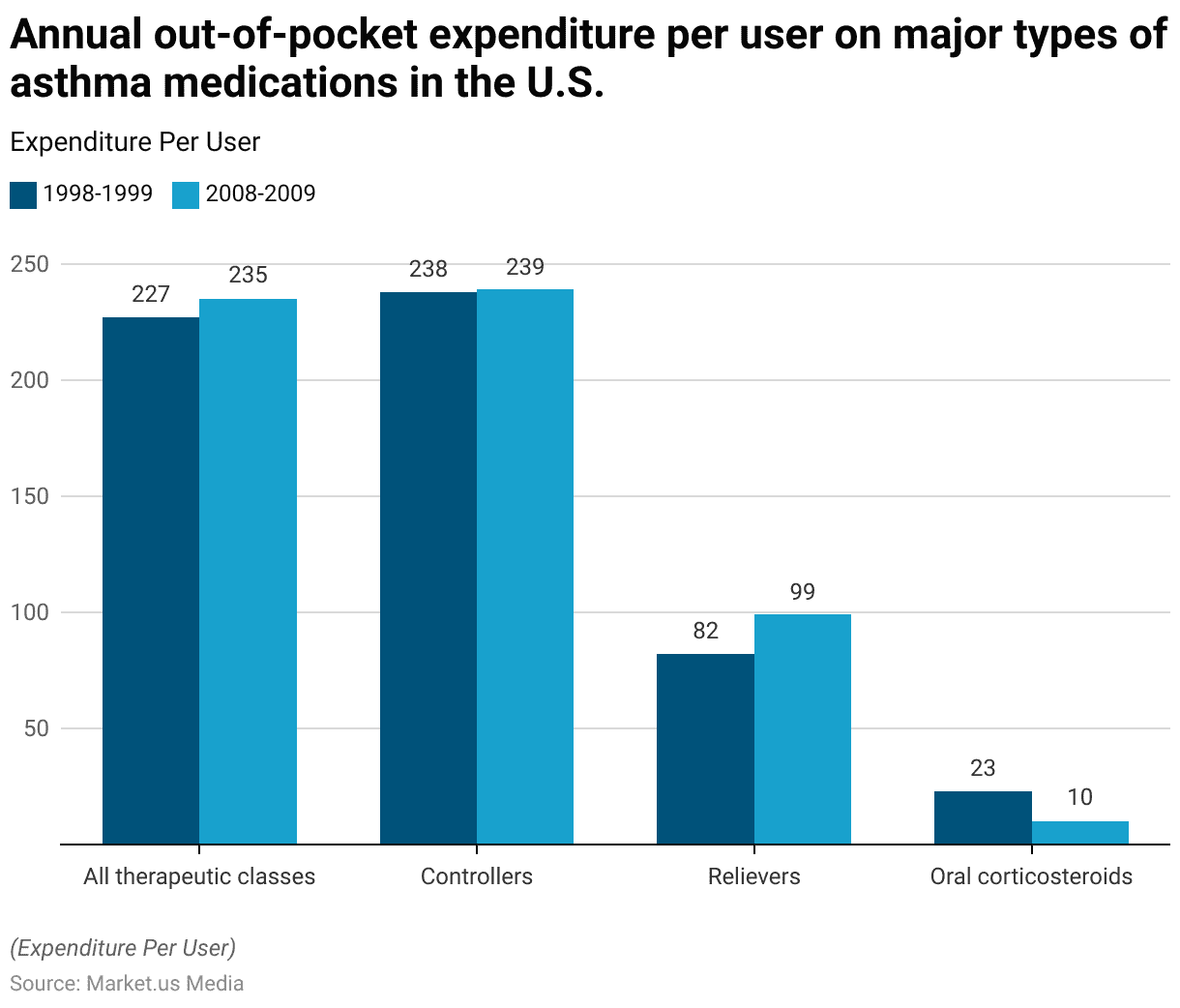
Asthma and COPD Drug Spending
- In the United States, the per member per month (PMPM) spending on asthma and COPD drugs has been projected to rise consistently from 2019 to 2024.
- Starting at $1.64 in 2019, PMPM spending increased to $1.83 in 2020 and continued its upward trend, reaching $1.96 in 2021.
- The projection for 2022 showed further growth to $2.11, with an anticipated continuation of this pattern, reaching $2.22 in 2023 and further rising to $2.32 by 2024.
- This steady increase in spending reflects the growing cost implications for healthcare plans and indicates a significant trend in the management and treatment of respiratory conditions over these years.
(Source: Statista)
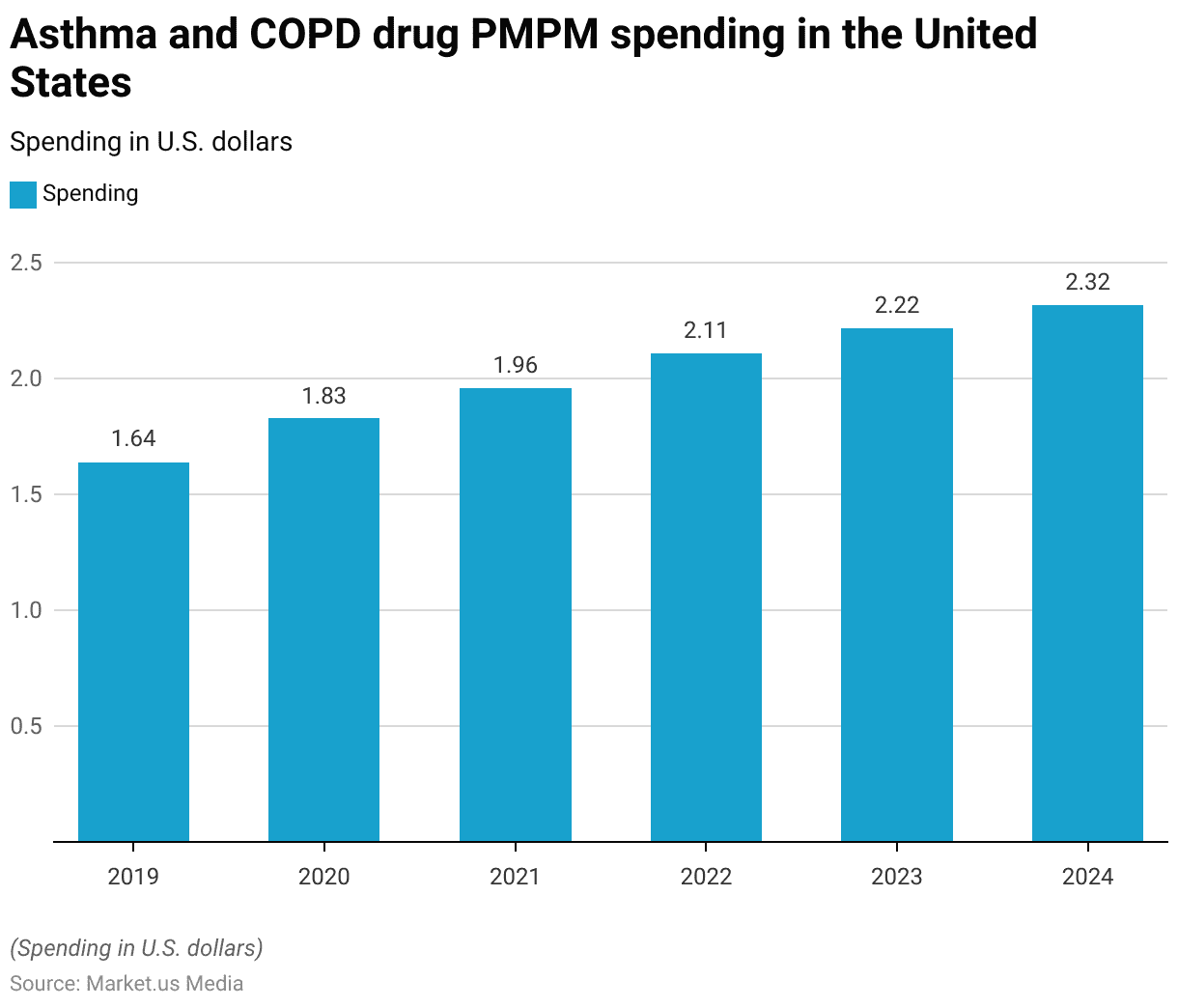
Attacks of Asthma Among Different Occupations
- Between 2011 and 2016, the prevalence of asthma attacks among U.S. working adults with current asthma varied significantly across different occupational sectors.
- Education, training, and library professionals experienced the highest prevalence, with 51.50% reporting asthma attacks within the past 12 months.
- Similarly, high rates were observed in the building and grounds cleaning and maintenance sector, as well as in the arts, design, entertainment, sports, and media sectors, at 51%.
- Healthcare practitioners and technical occupations also reported a high prevalence at 49.70%, closely followed by transportation and material moving occupations at 49.30%.
- Asthma attack prevalence in management roles was 46.90%, and computer and mathematical occupations saw a prevalence of 46.30%.
- Community and social services reported a rate of 46%, while health care support workers had 45.50%, and office and administrative support staff had 44.80%.
- The overall prevalence among all surveyed occupations was 44.70%. Lower rates were found in personal care and service at 44.60%, farming, fishing, and forestry at 43.80%, and sales and related occupations at 42.90%.
- The life, physical, and social sciences sectors reported a rate of 41.50%, business and financial operations were at 41%, and protective services were at 40.40%.
- Food preparation and service-related occupations, installation, maintenance, repair, legal, architecture and engineering, construction and extraction, and production sectors reported even lower rates, ranging from 40.20% down to 36.30%.
- These statistics highlight a notable disparity in asthma attack prevalence related to occupational exposure and conditions.
(Source: Statista)
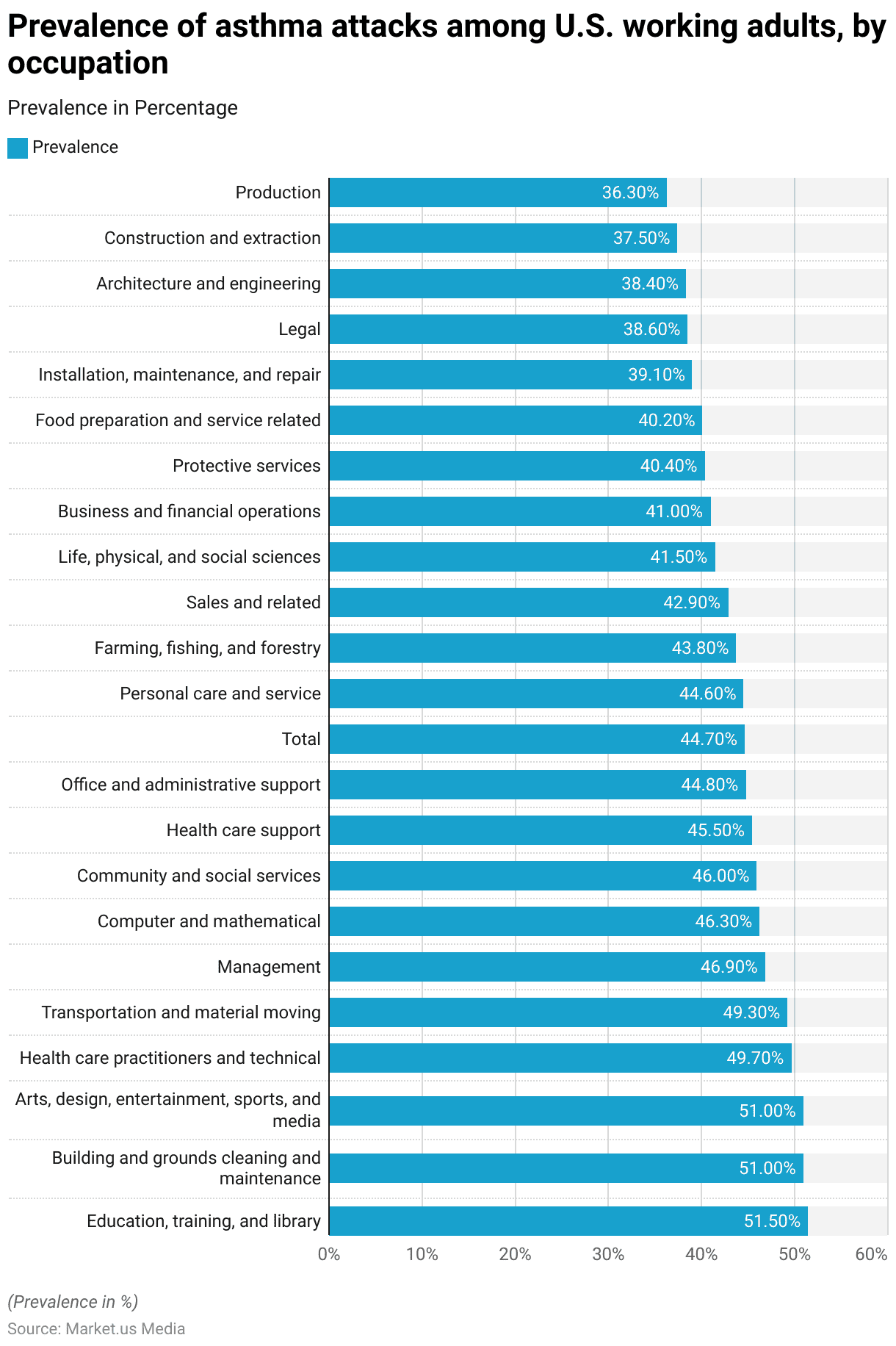
Asthma Care Measures
- From 2013 to 2021, the provision of asthma care measures in the United Kingdom demonstrated varying trends across several key indicators.
- In 2013, 74% of individuals received an annual asthma review, and 78% had their inhaler technique checked, but only 24% had an asthma action plan, and the overall basic care provision stood at 20%.
- Over the next few years, there were improvements in all areas: by 2014, annual reviews rose to 77%, and asthma action plans increased to 30%, with overall basic care provision at 25%.
- These improvements continued, peaking in 2018 when 80% received annual reviews, 81% had their inhaler technique checked, 48% had an asthma action plan, and overall basic care provision reached 40%.
- However, a decline was observed from 2019 onwards, with a notable drop in 2021, where only 65.7% received annual reviews, 66.5% had their inhaler technique checked, although asthma action plans slightly increased to 52.7%, but overall basic care provision decreased to 29.7%.
- Further, this period highlights significant initial improvements in asthma care that were followed by a decline in recent years, emphasizing the challenges in sustaining healthcare quality over time.
(Source: Statista)
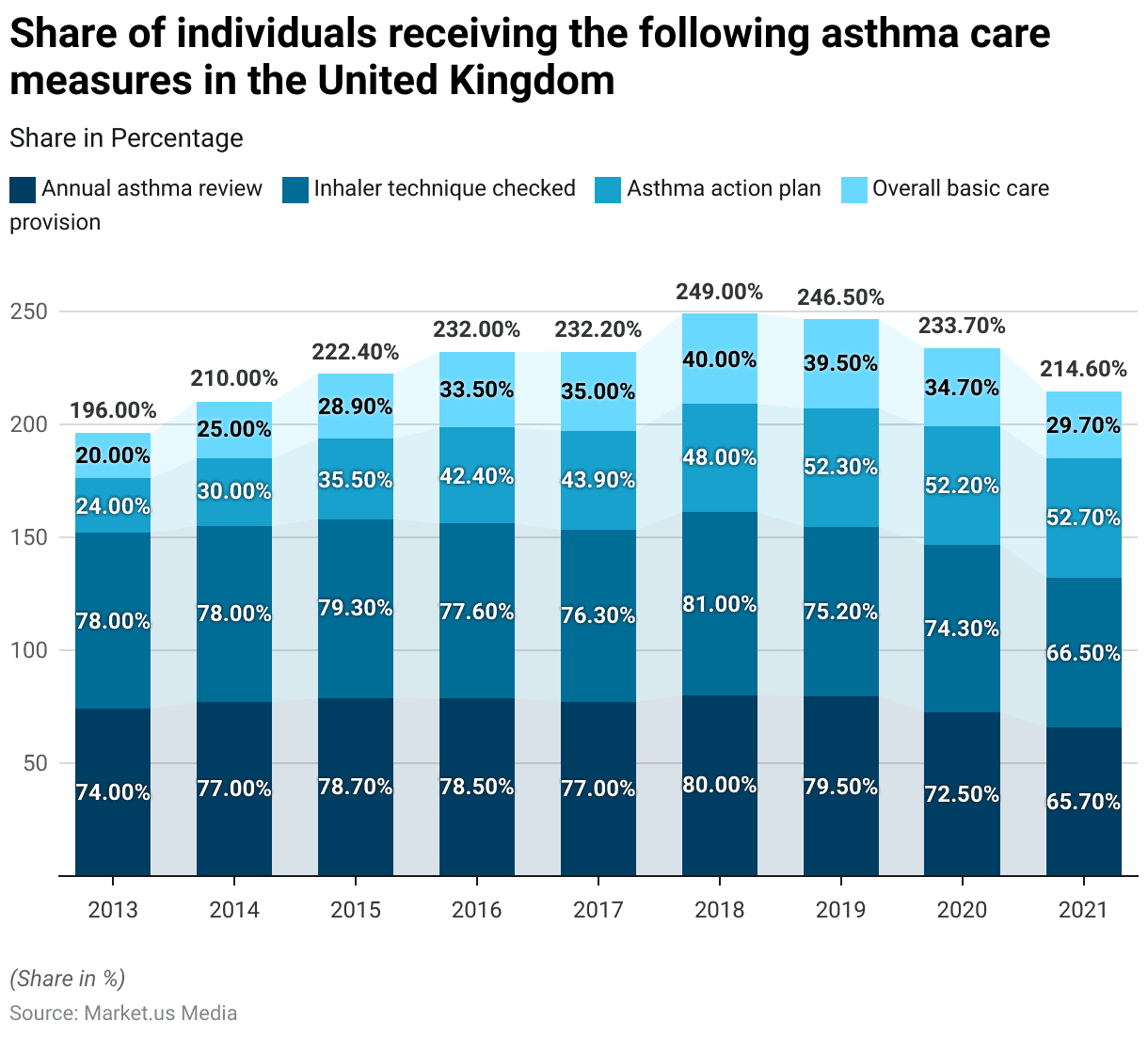
Initiatives to Combat Asthma
- Efforts to manage and combat asthma involve a comprehensive array of programs and initiatives led by various organizations globally.
- The CDC’s National Asthma Control Program (NACP) allocates funding to enhance the quality, reach, and effectiveness of asthma services across the U.S. Particularly targeting improvements in asthma management, reducing air pollution, and enhancing care quality.
- Further, In alignment with the NACP’s objectives, the Community Health Interventions to Advance Self-Management of Asthma (CHI-ASMA) by the Asthma and Allergy Foundation of America (AAFA) focuses on high-risk groups, promoting asthma self-management education and reducing environmental triggers.
- Moreover, the Global Initiative for Asthma (GINA) emphasizes global awareness and the dissemination of effective asthma management practices through its strategy documents and annual World Asthma Day events.
- Programs like EXHALE, a strategic framework from the CDC, detail specific interventions such as enhancing environmental conditions to minimize asthma triggers and promoting comprehensive smoking bans to mitigate exposure.
- Additionally, the National Asthma Education and Prevention Program (NAEPP) contributes to these efforts by advising federal agencies on asthma care and promoting public and healthcare professionals’ education.
- These initiatives collectively aim to reduce asthma morbidity and mortality through evidence-based strategies, focusing on education, environmental health, and policy advocacy to ensure effective asthma management at both individual and community levels.
(Source: CDC, Asthma & Allergy Foundation of America, Global Initiative for Asthma – GINA, NHLBI, NIH)
Regulations for Asthma Treatment
- Asthma treatment regulations and policies vary significantly across countries, shaped by public health systems and legal frameworks.
- Globally, organizations such as the World Health Organization (WHO) and the Global Initiative for Asthma (GINA) provide guidelines, but local adaptation is common.
- In the U.S., the National Asthma Control Program (NACP) works to reduce asthma-related morbidity and mortality by implementing evidence-based practices.
- The European Union focuses on harmonizing treatment standards through initiatives like the E.U. Medical Device Regulation, ensuring the availability of essential medications such as inhaled corticosteroids. In low- and middle-income countries, the challenge often lies in access to affordable, quality-assured medications.
- For example, the WHO promotes the inclusion of Smart Inhalers in essential medicine lists to address disparities in asthma care.
- Regulatory bodies in these countries strive to improve access but face challenges related to funding and infrastructure.
- Overall, legislation typically mandates improved surveillance, increased funding for asthma programs, and better access to care. With a focus on both treatment and environmental factors like air quality.
(Sources: Global Asthma Report, American Lung Association, Global Initiative for Asthma – GINA)
Recent Developments
Acquisitions and Mergers:
- AstraZeneca acquires TeneoTwo: In 2023, AstraZeneca acquired TeneoTwo, a biotech company focused on respiratory treatments, for $100 million. This acquisition strengthens AstraZeneca’s portfolio of asthma treatments, particularly in developing biologics aimed at severe asthma cases.
- Sanofi completes merger with Kymab: In early 2024, Sanofi merged with Kymab, a UK-based biotech company specializing in immunology, for $1.1 billion. This merger enhances Sanofi’s asthma-related drug pipeline, especially in developing novel antibody treatments for chronic asthma.
New Product Launches:
- GSK launches Trelegy Ellipta for asthma: In 2023, GlaxoSmithKline (GSK) launched Trelegy Ellipta. An inhaler approved for asthma treatment, offering patients a once-daily triple therapy. It was shown to reduce exacerbations by 15% in clinical trials compared to previous treatments.
- Teva Pharmaceuticals introduces Digital Inhaler: In March 2024, Teva Pharmaceuticals introduced a new digital inhaler. Integrating sensors and an app that tracks usage and helps manage asthma symptoms. The device is aimed at improving adherence to prescribed asthma medications.
Funding:
- Propeller Health secures $50 million for smart inhaler technology: In 2023, Propeller Health, a leader in connected respiratory devices, raised $50 million to expand its smart inhaler platform. The funding will be used to develop new features and expand its reach to more asthma patients globally.
- Verona Pharma raises $100 million for COPD and asthma treatment: In late 2023, Verona Pharma secured $100 million in funding to support the development of ensifentrine. An inhaled therapy targeting asthma and chronic obstructive pulmonary disease (COPD). The funding will be used for further clinical trials and market expansion.
Technological Advancements:
- AI-driven asthma management: By 2025, it is projected that 35% of asthma patients will use AI-powered apps and devices to manage their conditions. Helping to predict asthma attacks and adjust medications in real-time.
- Gene therapy for asthma: Gene therapy is emerging as a potential treatment for asthma. By 2026, 10% of asthma-related clinical trials will focus on gene-editing techniques aimed at reducing inflammation and long-term symptoms.
Conclusion
Asthma Statistics – Asthma is a prevalent chronic respiratory condition that significantly impacts health globally.
Characterized by symptoms like wheezing, shortness of breath, and chest tightness. Asthma is exacerbated by triggers such as allergens, cold air, and respiratory infections.
Despite advancements in pharmacological treatments and management strategies. Asthma remains a complex disease that varies widely in severity and individual response to treatments.
Moreover, the disorder’s prevalence and the effectiveness of management strategies differ significantly among various demographics and occupational groups, highlighting the need for personalized care and continued research.
Finally, addressing these challenges through education, targeted public health interventions, and policy-making is essential for improving the quality of life for people with asthma and reducing the overall health burden.
FAQs
Asthma is a chronic lung disease that inflames and narrows the airways, causing recurring periods of wheezing, chest tightness, shortness of breath, and coughing.
Common asthma triggers include allergens (like pollen, dust mites, pet dander, and molds), air pollution, respiratory infections, cold air, physical activity, smoke, and strong emotions.
Asthma is diagnosed based on medical history. A physical examination, and tests such as lung function tests (spirometry), peak flow measurement, and sometimes allergy tests.
There is no cure for asthma, but it can be managed with proper treatment and strategies to avoid triggers. Many people with asthma lead full and active lives.
Several types of asthma exist, including allergic (extrinsic) asthma, non-allergic (intrinsic) asthma, exercise-induced bronchoconstriction (EIB), occupational asthma, and asthma with chronic obstructive pulmonary disease (COPD).
Discuss your needs with our analyst
Please share your requirements with more details so our analyst can check if they can solve your problem(s)



